
发布时间: Mon May 08 14:06:58 CST 2023
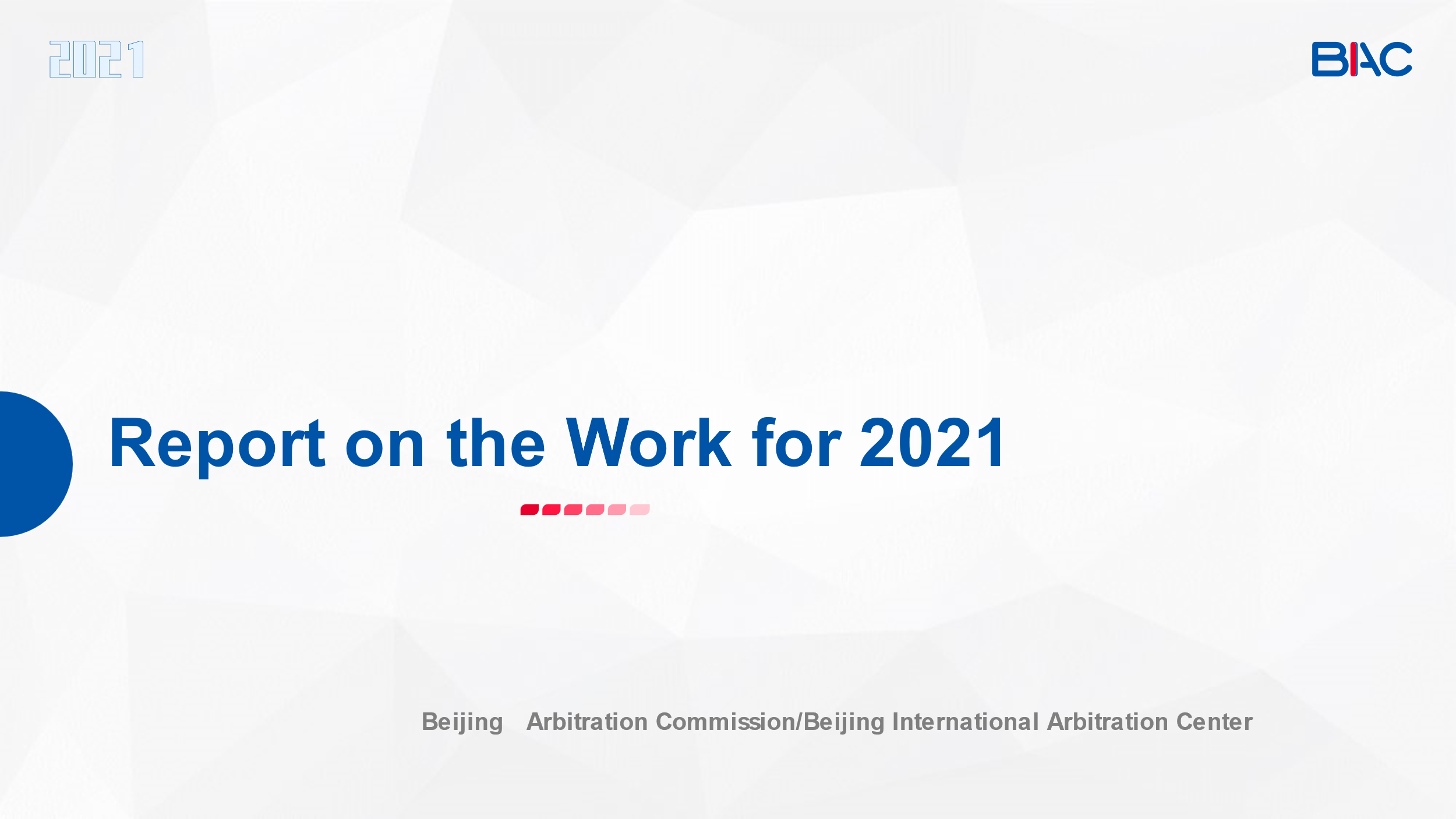
2021 witnessed a rise in the caseload and the amount in dispute of the Beijing Arbitration Commission/Beijing International Arbitration Center (the "BAC/BIAC") compared to 2020, exceeding RMB 100 billion for the first time. With the normalization of epidemic prevention and control, the BAC/BIAC 's work has entered into normal state. The efficiency and quality of case filing and handling improved significantly compared with those of 2020. Notable results were made in business development work, and internal management were further improved. The Committee better played its decision-making and oversight role by revising the Articles of Association. Based on the 2021 work completed, the BAC/BIAC hereby makes its annual summary as follows:
I. Case Management
(I) Overview
1. Statistics on Arbitration Cases
(1) Caseload
|
Arbitration procedures |
Number of Cases |
Year-on-year Growth (amount/rate) |
|
Expedited Procedure |
6074 |
1781/41.49% |
|
Ordinary Procedure |
1414 |
305/27.5% |
|
Ordinary Procedure for International Commercial Arbitrations |
83 |
7/9.21% |
|
Expedited Procedure for International Commercial Arbitrations |
166 |
27/19.42% |
|
Total |
7737 |
2120/37.74% |
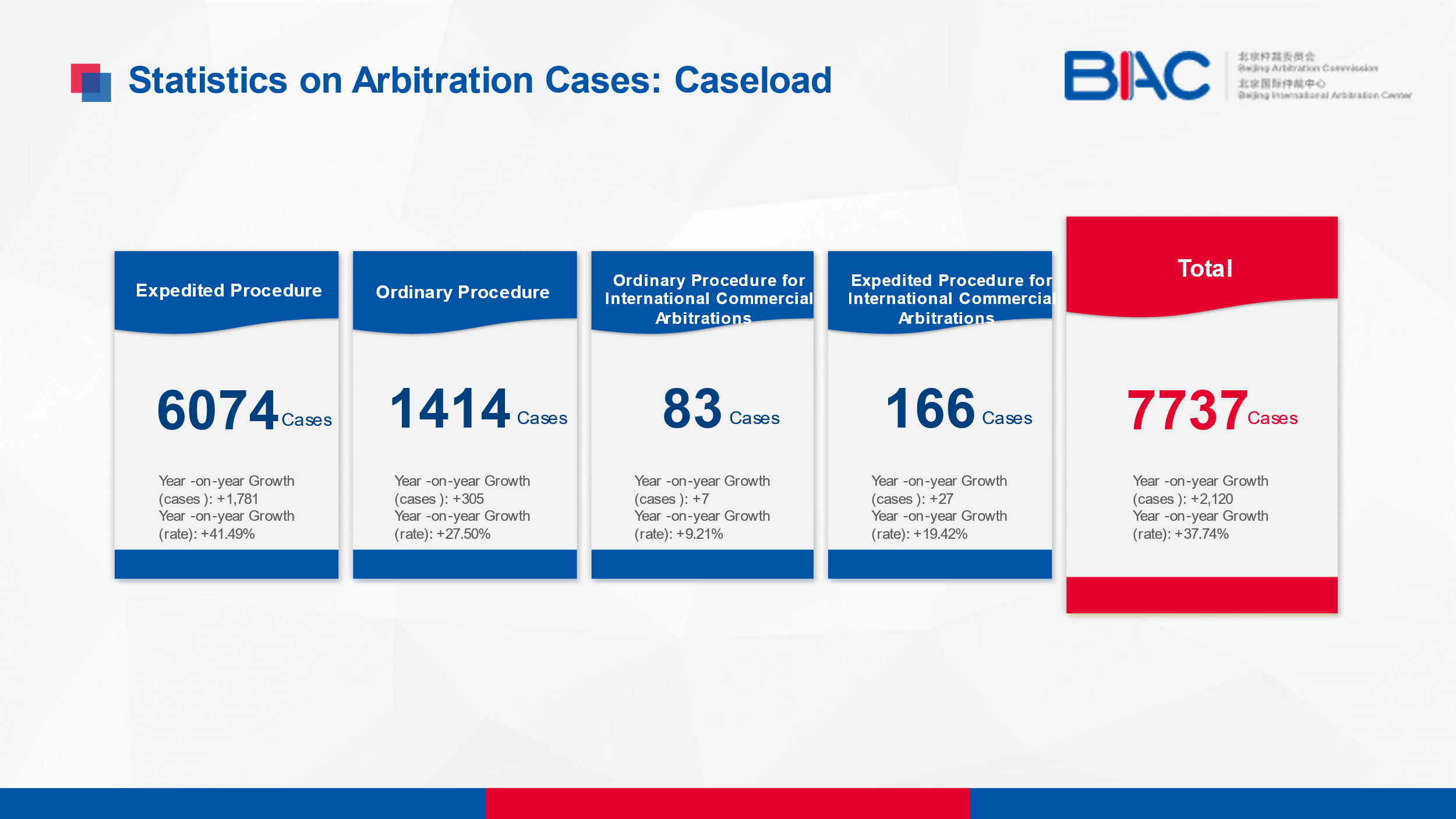
(2) Amounts in Dispute
|
Category of Amounts in Dispute |
Amounts |
Year-on-year Growth (amounts/rate) |
|
Actual Amounts in Dispute |
RMB 104.226 billion |
RMB 10.22 billion/10.87% |
|
Amounts in Dispute Registered |
RMB 101.011 billion |
RMB 10.028 billion/11.02% |
|
Average Amounts in Dispute Registered |
RMB 13.0556 million |
RMB 3.1422 million/-19.4% |
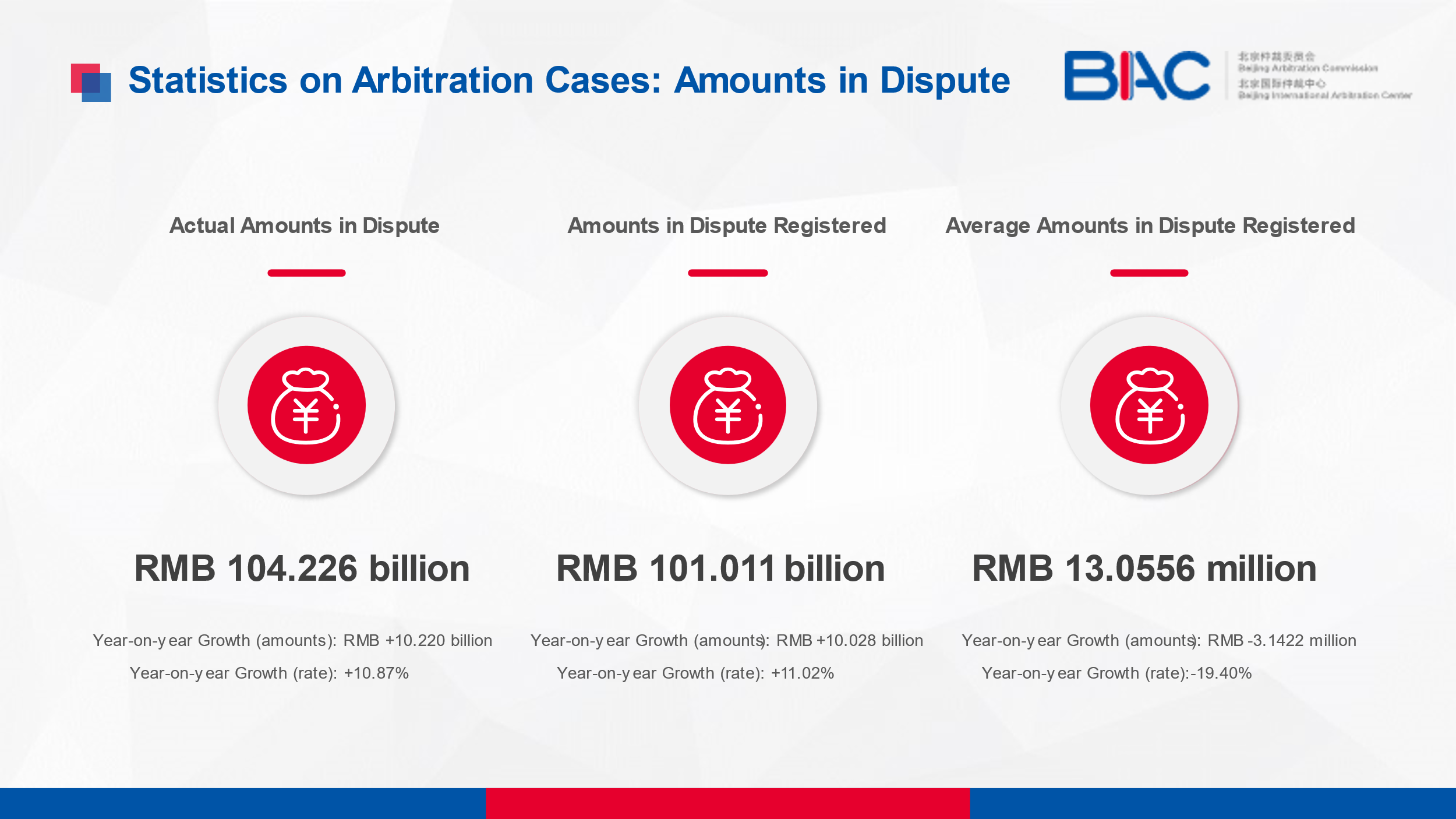
|
Category of Amounts in Dispute |
Number of Cases |
Average Amount in Dispute (RMB 10,000) |
Proportion in the Total Amounts of Cases Registered |
Year-on-year Growth (amount/rate) |
|
Below RMB 1 million |
3937 |
35.02 |
1.37% |
1199/43.79% |
|
RMB 1 million (included) - 5 million |
2232 |
233.2 |
5.15% |
591/36.01% |
|
RMB 5 million (included) - 50 million |
1275 |
1452.86 |
18.34% |
282/28.4% |
|
RMB 50 million (included) - 100 million |
144 |
7157.07 |
10.2% |
44/44% |
|
Above RMB 100 million (included) |
149 |
44024.65 |
64.94% |
4/2.76% |
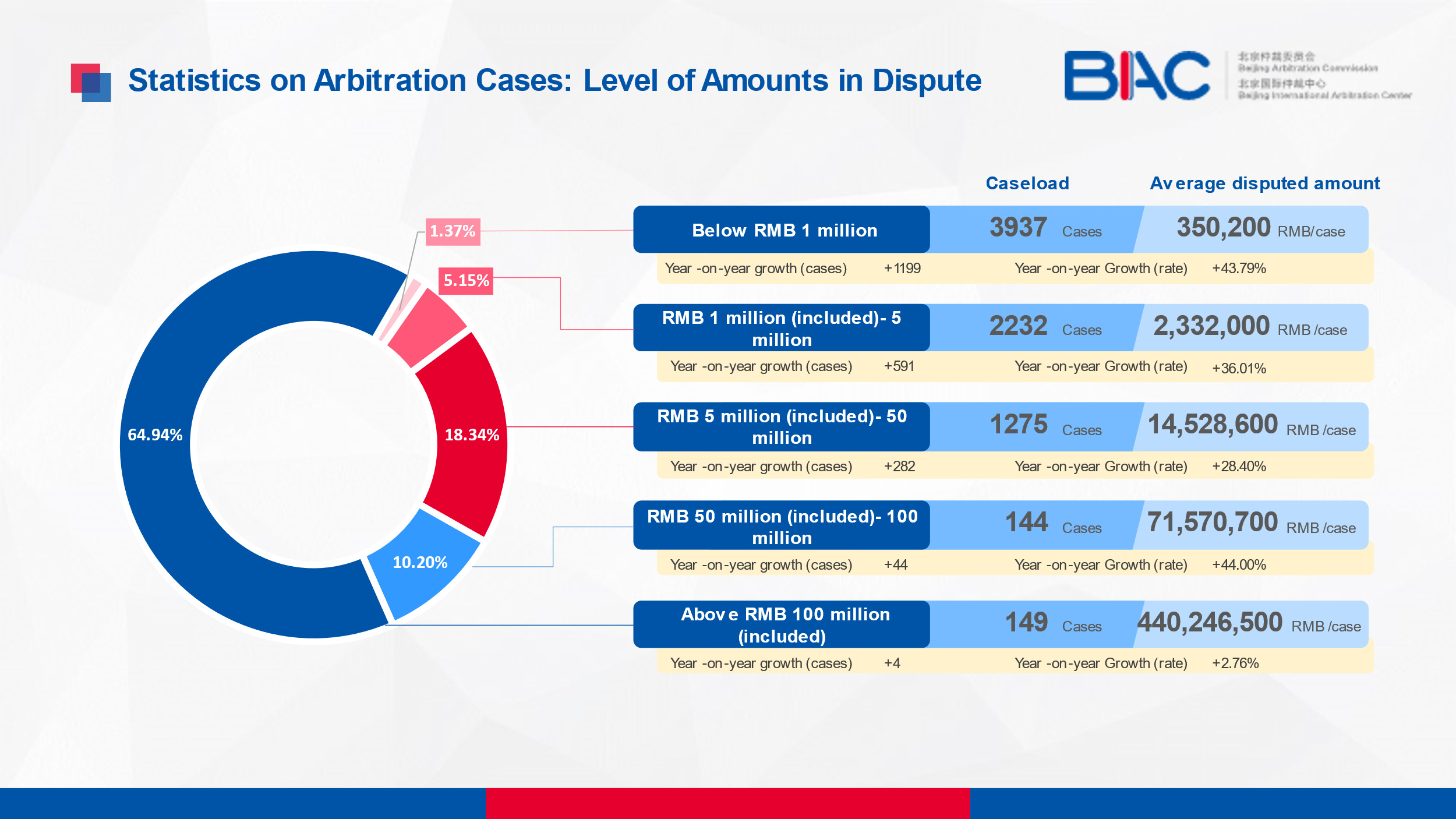
(3) Nature of the Disputes
|
Category |
Number of Cases |
Proportion in the Total Cases Registered |
Year-on-year Growth (amount/rate) |
|
Finance |
2502 |
32.34% |
372/17.46% |
|
Sales |
1996 |
25.80% |
835/71.92% |
|
Construction Engineering |
1158 |
14.97% |
421/57.12% |
|
Services |
674 |
8.71% |
143/26.93% |
|
IPR |
502 |
6.49% |
121/31.76% |
|
Lease |
473 |
6.11% |
138/41.19% |
|
Entrustment |
245 |
3.17% |
74/43.27% |
|
Processing |
49 |
0.63% |
-12/-19.67% |
|
Transportation |
28 |
0.36% |
12/75% |
|
Others |
110 |
1.42% |
16/17.02% |
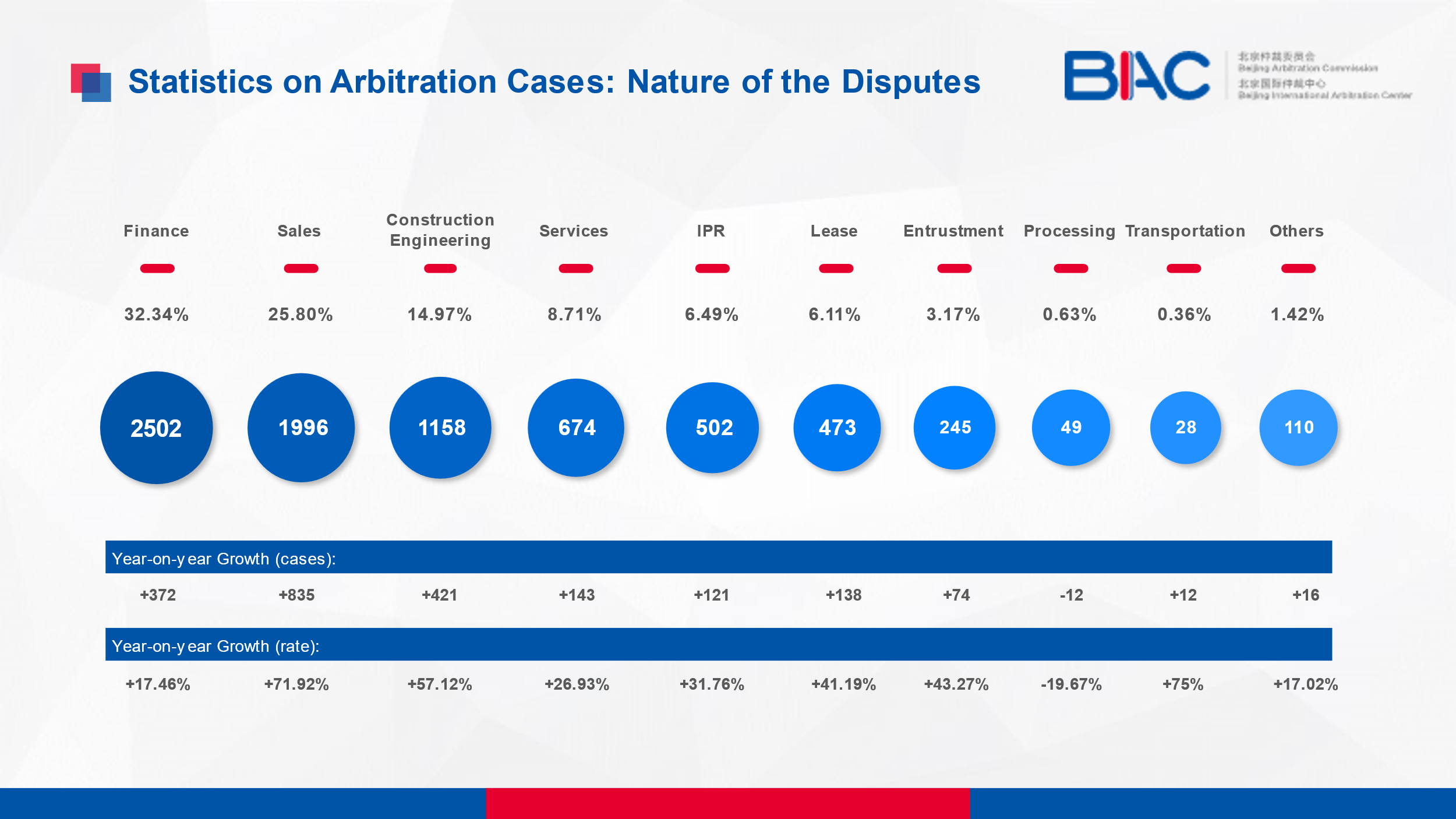
2. Arbitration Cases Concluded
(1) Cases and Amounts Concluded
|
Indicator |
Figures |
Year-on-year Growth (amount/rate) |
|
Cases Concluded |
7,216 |
1,942/36.82% |
|
Amounts Concluded |
RMB 108.744 billion |
RMB 36.148 billion/49.79% |
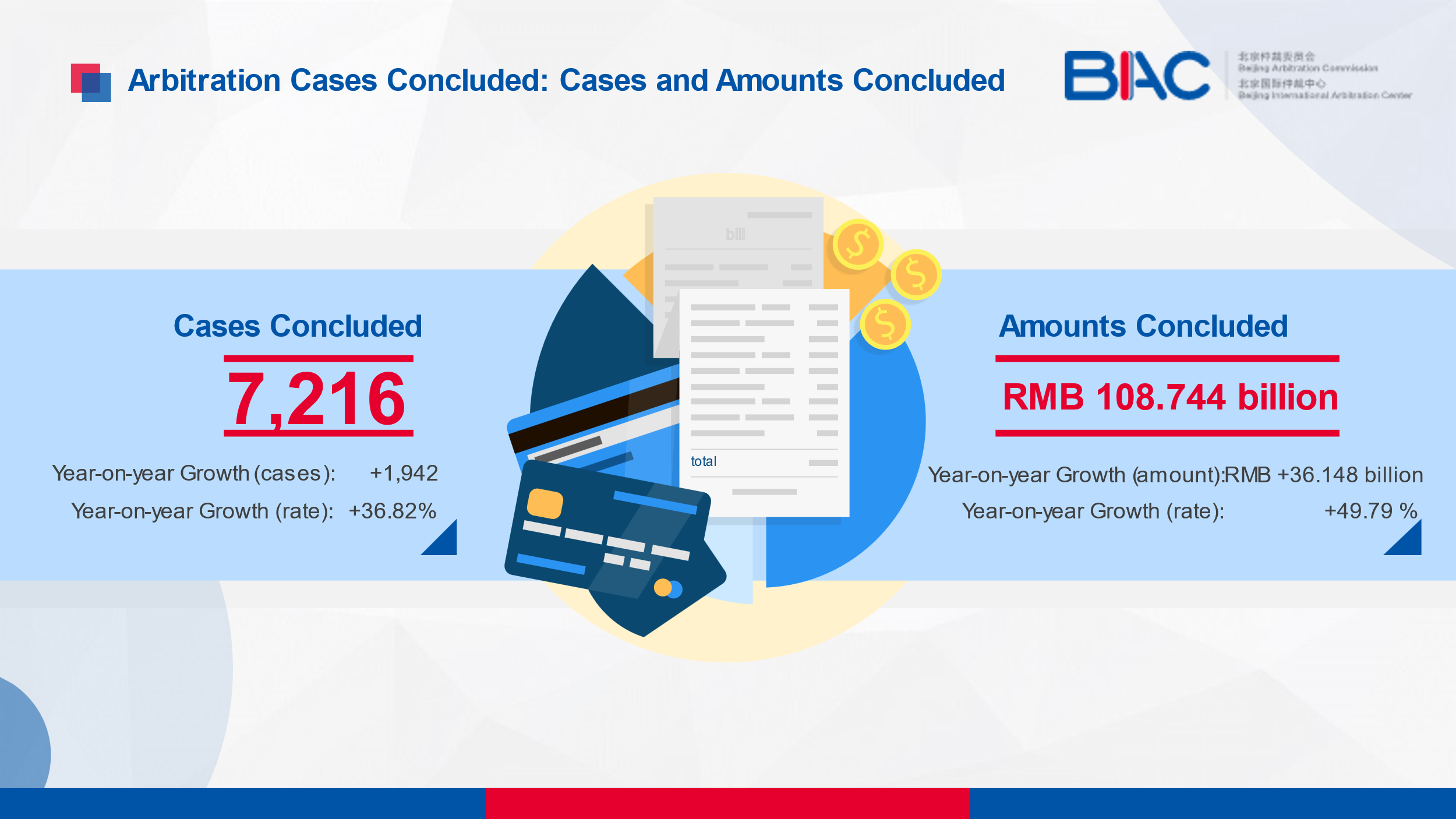
(2) Types of Conclusion
|
Types of Conclusion |
Number of Cases Concluded |
Proportion in the Total Cases Concluded |
Year-on-year Growth (days/rate) |
|
Award |
4434 |
61.45% |
1246/39.08% |
|
Settlement |
1161 |
16.09% |
340/41.41% |
|
Withdrawal |
1621 |
22.46% |
356/28.14% |
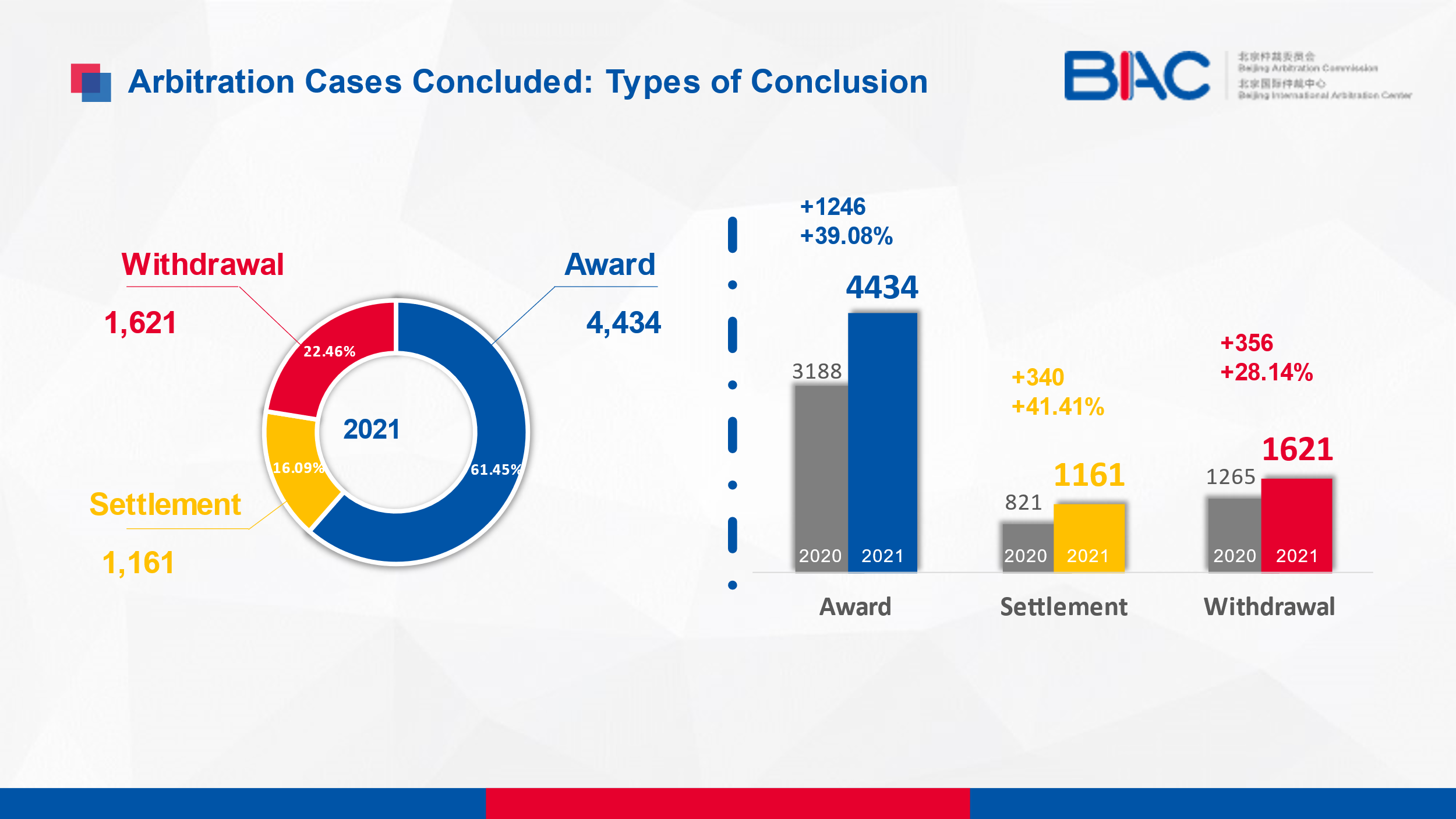
3. International Commercial Arbitrations, Special Procedure-based Arbitrations and Arbitrations Involving at Least One Party Outside Beijing
(1) International Commercial Arbitrations
|
Indicators |
Figures |
Proportion in Total Cases Registered/Total Amounts in Dispute |
Year-on-year Growth (amount/rate) |
|
Number of Cases |
249 |
3.22% |
34/15.81% |
|
Amounts in Dispute |
RMB 4.812 billion |
4.76% |
RMB -8.462 billion/-63.74% |
|
Average Amounts in Dispute |
RMB 19.3266 million |
- |
RMB -42.413 billion/-68.69% |
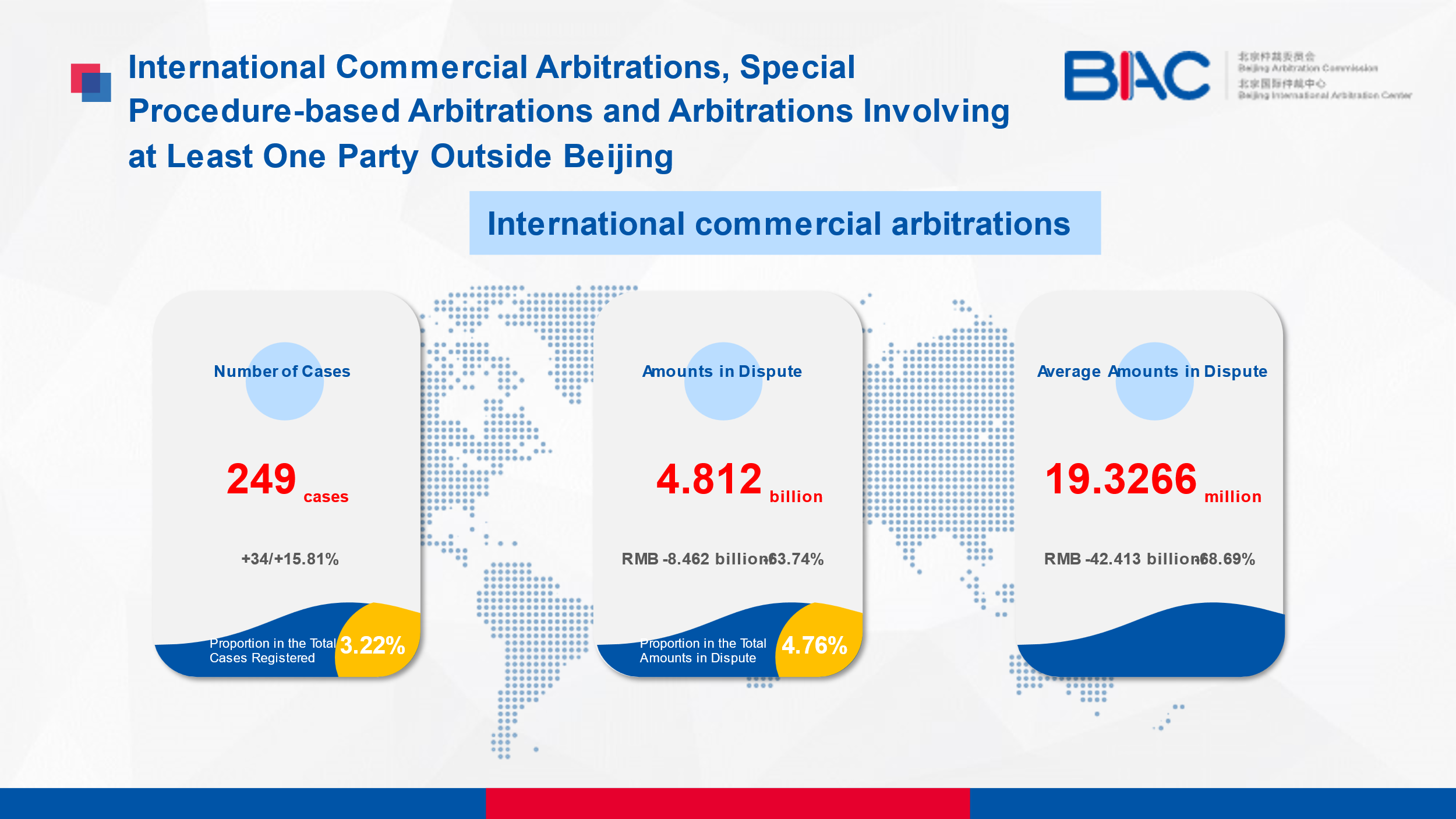
Among the international cases registered in 2021, the largest amount in dispute for a single case reached RMB 520 million, and 11 cases were caught in an amount in dispute exceeding RMB 100 million. Geographically, the parties came from 25 countries or regions, including Hong Kong (China), Macao (China), Taiwan (China), the Cayman Islands, the United States, Canada, Australia, Germany, South Korea, Japan, the United Kingdom, Malaysia, Singapore, Italy, the United Arab Emirates, Cambodia, Denmark, Myanmar, Chile, Croatia, Thailand, Africa, the Netherlands, Finland and Sweden. Noticeably, parties from eight countries, including Denmark, Finland, the Netherlands, Croatia, Myanmar, Sweden, Chile and the Central African Republic, were registered for the first time. A total of 14 cases comprised both parties with entities outside the Chinese Mainland. Since its establishment, the international cases administered by the BAC/BIAC counted the parties from up to 54 countries and regions.
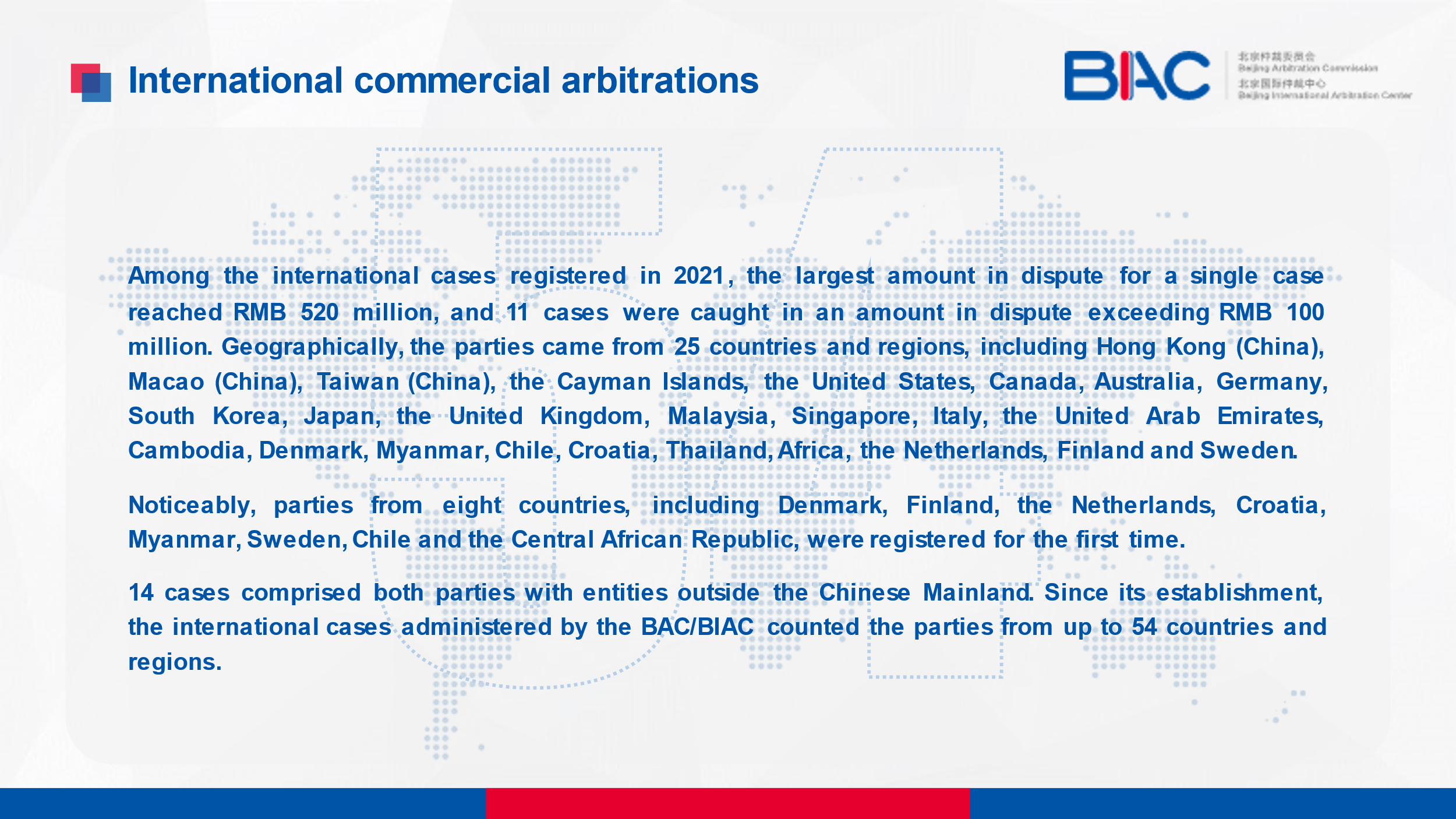
(2) Special Procedure-based Arbitrations
In 2021, among registered international cases, the parties in 11 cases agreed to use English as the arbitration language; English was actually used as the arbitration language in eight cases; and the parties in four cases agreed on the use of the United Nations Convention on Contracts for the International Sales of Goods. Besides, one case each fixed the laws of Thailand, Hong Kong (China), China and Sri Lanka, China and Bangladesh, Singapore, Warsaw Convention, Montreal Convention and Hague-Visby Rules as the applicable substantive laws, respectively. In addition, the parties in three cases agreed to incorporate special procedural arrangements in the arbitration clauses, including extending the time limit for arbitrator selection, limiting the time for filing documents, setting the objection period for the appointed arbitrators and limiting the length of arbitral awards, while the parties in another three cases selected arbitrators not included in the Panel of Arbitrators of the BAC/BIAC. In two cases, emergency arbitrators were appointed and decisions on interim measures were made (the claimant's application was supported in one case and rejected in another; in the former case, the respondent applied for the tribunal to revoke the decision made by the emergency arbitrator, while its application was rejected by the tribunal).
(3) Arbitrations Involving at Least One Party Outside Beijing
|
Parties outside Beijing |
Number of Cases |
Proportion in Domestic Cases |
Year-on-year Growth (days/rate) |
|
Both parties outside Beijing |
1907 |
25.47% |
501/35.63% |
|
One party outside Beijing |
3680 |
49.15% |
1285/53.65% |
|
Total |
5587 |
74.61% |
1786/46.99% |
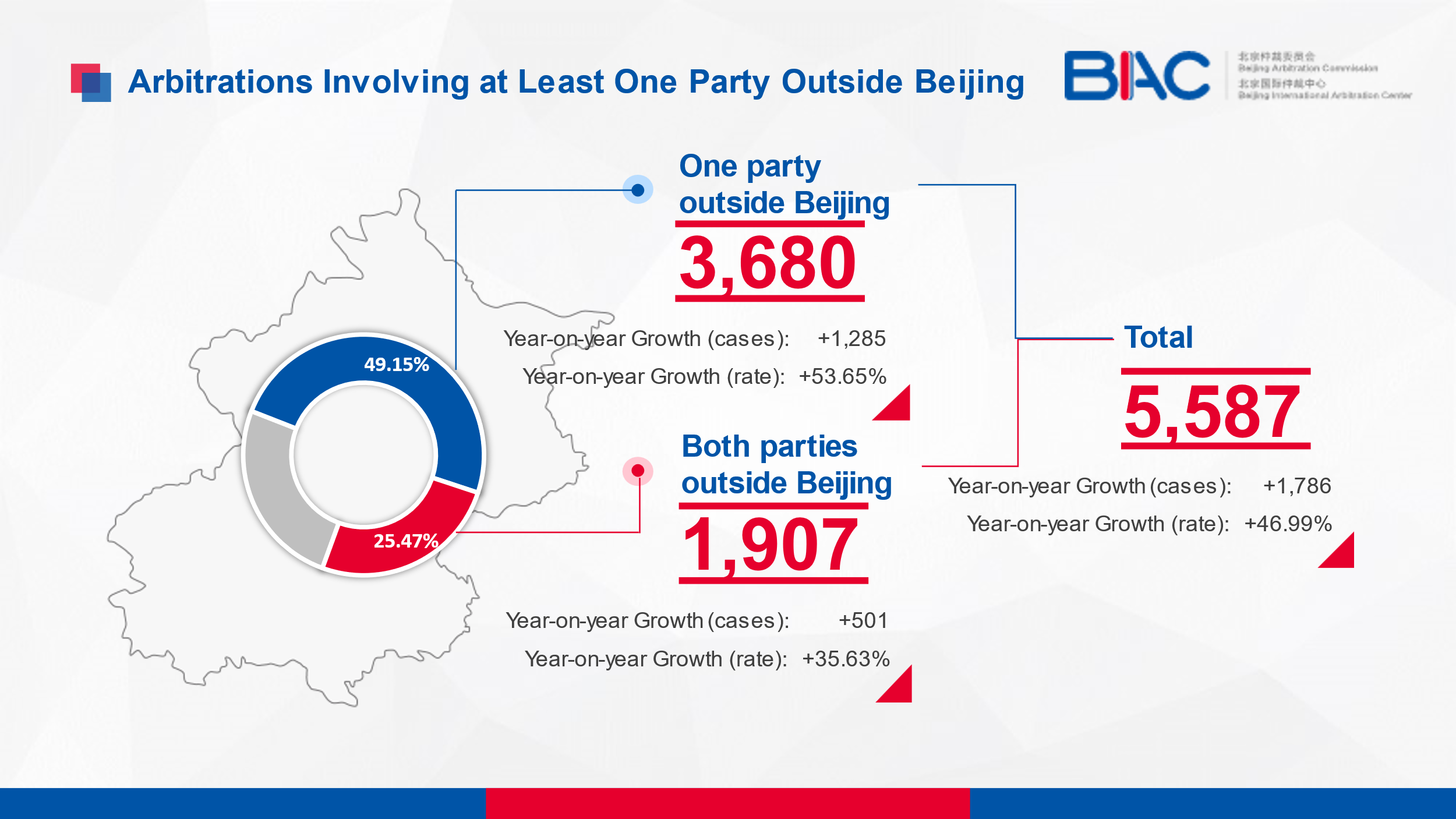
4. Independent Mediation of the BAC/BIAC Mediation Center
In 2021, ten cases were registered at the BAC/BIAC Mediation Center with a total amount in dispute of RMB 4.407 billion, six of which were concluded. According to the sources of the cases, five were registered directly by the parties to the BAC/BIAC Mediation Center and five were referred by industry associations. As for case types, six were investment and financial cases, and four were construction cases.
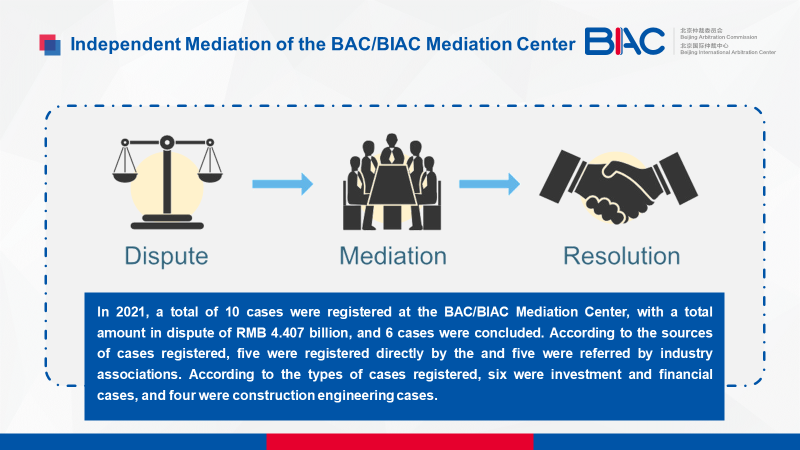
(II) Arbitration Efficiency
1. Duration of Arbitrations
|
Average Duration |
Days |
Year-on-year Growth (days/rate) |
|
From registration to conclusion |
173.55 |
-24.82/-12.51% |
|
From formation of tribunal to conclusion |
101.72 |
-10.07/-9.01% |
|
Median Duration |
Days |
Year-on-year Growth (days/rate) |
|
From registration to conclusion |
139 |
-35/-20.11% |
|
From formation of tribunal to conclusion |
76 |
-5/-6.17% |
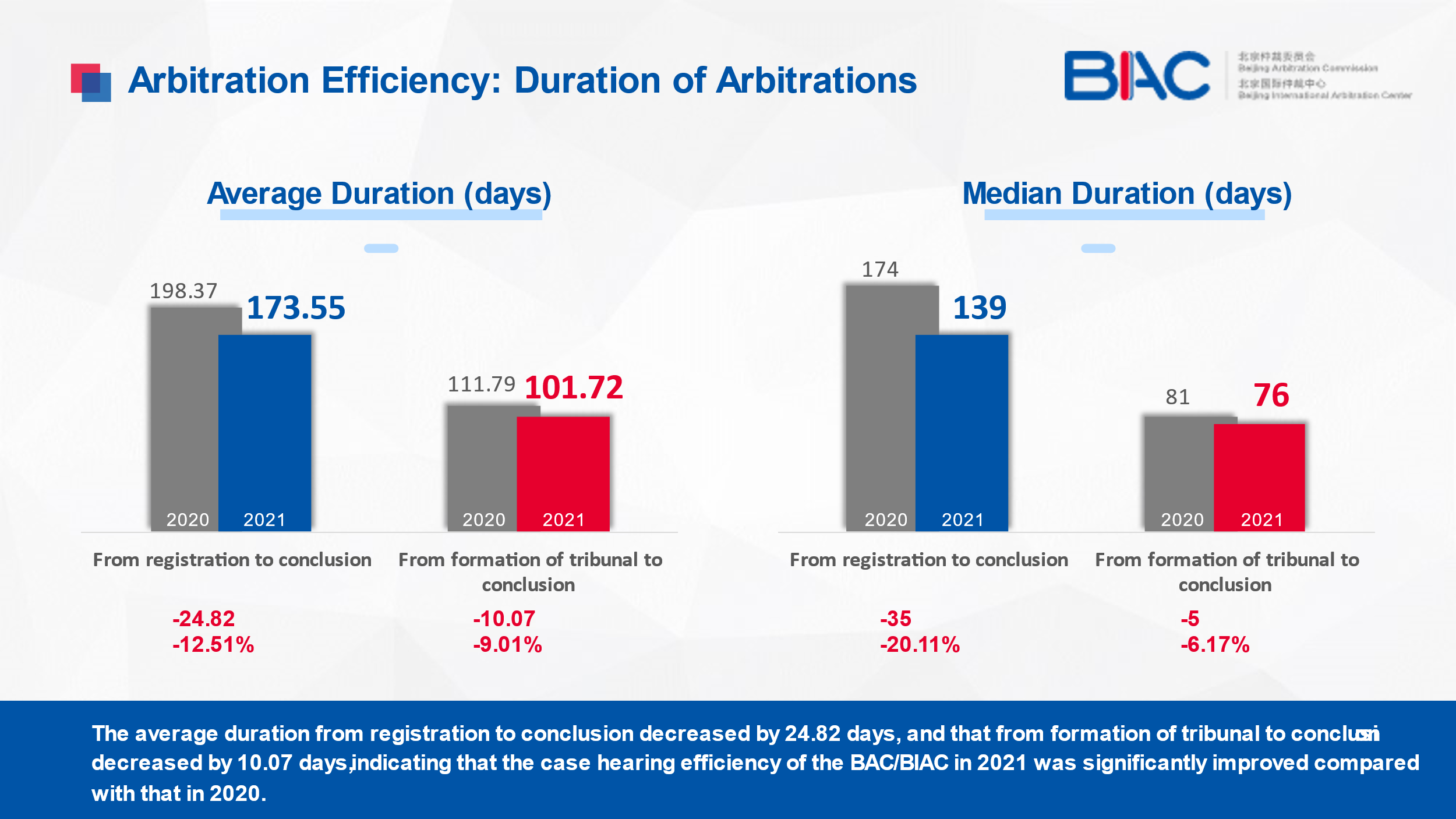
Cases Concluded in 2021 (by duration)
|
Specific Duration |
Number of Cases |
Proportion in Total Cases Concluded |
Year-on-year Growth (cases/rate) |
|
Within the time limit |
4320 |
59.87% |
1317/43.86% |
|
Overdue for less than 6 months |
2551 |
35.35% |
559/28.06% |
|
Overdue for 6-12 months |
203 |
2.81% |
9/4.64% |
|
Overdue for 1-2 years |
107 |
1.48% |
45/72.58% |
|
Overdue for more than 2 years |
35 |
0.49% |
12/52.17% |

Statistics on Long-standing Arbitration Cases as of 31 December 2021
|
Overdue Time |
Number of Cases |
Overdue Time |
Number of Cases |
|
Within 1 year |
641 |
Overdue for 1-2 years |
104 |
|
2-3 year |
25 |
3-4 years |
17 |
|
4-5 years |
3 |
5-6 years |
1 |
|
Overdue for more than 10 years |
1 |
Total |
792 |
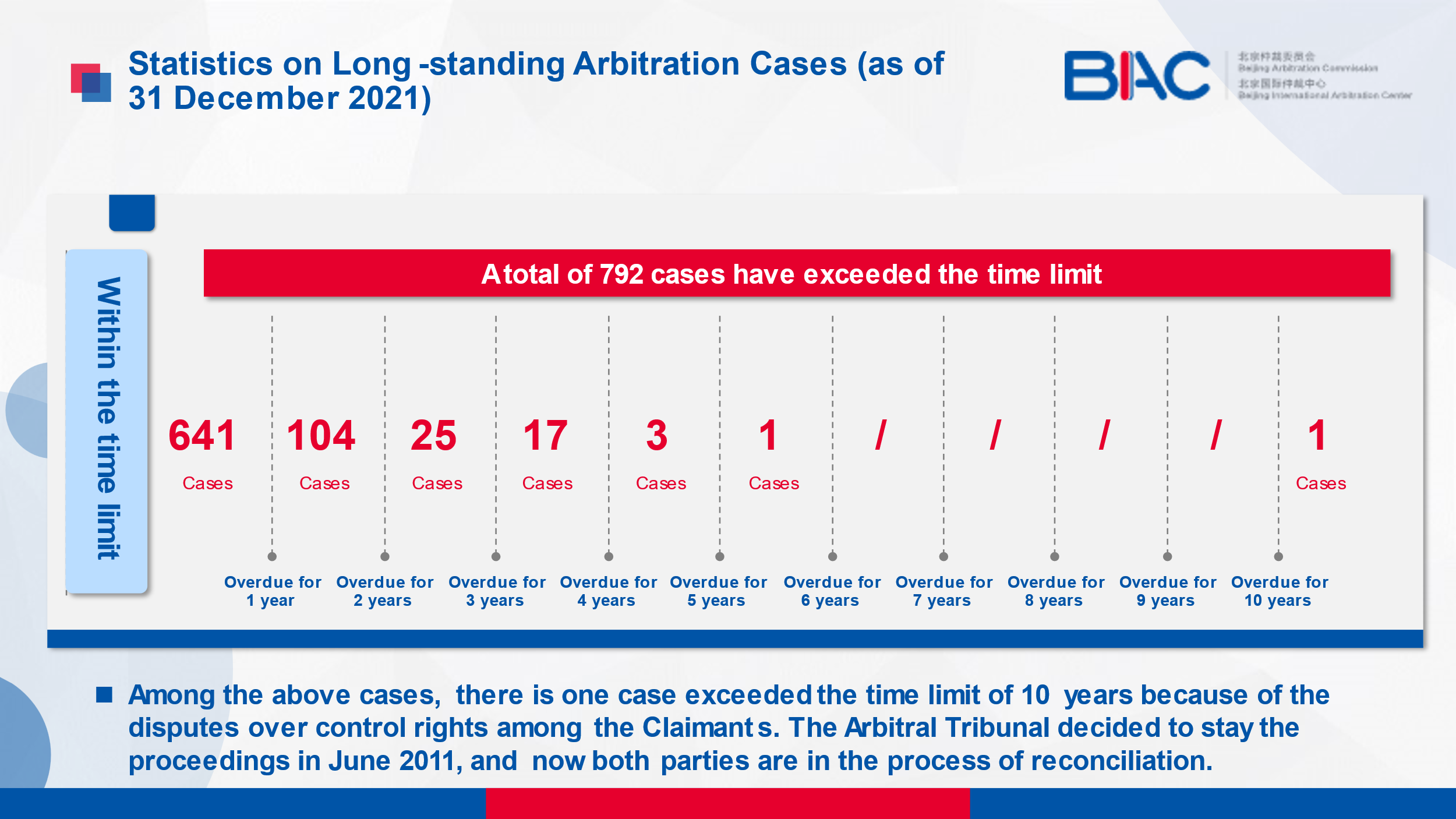
(III) Case Quality
1. Cases with Expert Consultation
In 2021, 31 cases resorted to expert consultation, increasing by 24 cases from the previous year, with a growth rate of 343%.
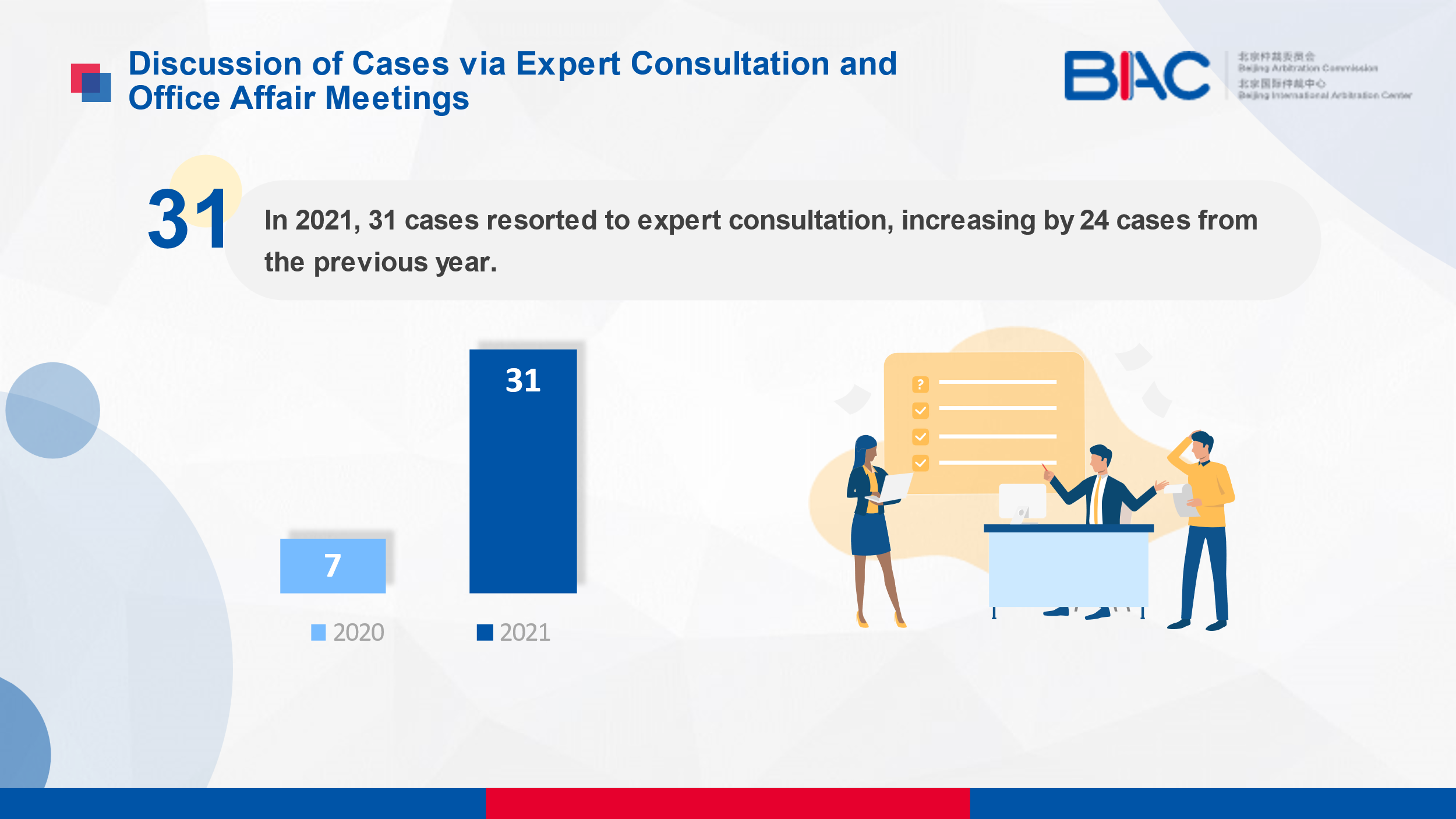
2. Revocation of Awards, Refusal to Enforce and Re-arbitration
2021 witnessed one award partially revoked by a court, one not enforced by courts outside Beijing, and four subjected to re-arbitration according to the orders of courts. As for the arbitral award that was partially revoked, the court found that the warrantor's signature was forged. Among the four arbitral awards subjected to re-arbitration, one involved the failure of information disclosure by arbitrators, two involved the forging of signatures and seals, and one involved the intentional concealment of evidence by the claimant. The arbitral tribunal agreed on re-arbitration after communication. As for the arbitral award that was not enforced, the court ruled not to enforce the award because the respondent had not participated in the arbitral proceedings and the claimant had not submitted a valid arbitration agreement. The BAC/BIAC believed that there was a lack of factual and legal basis to support the court’s decisions, and had submitted written statements to the Intermediate People's Court who ruled not to enforce the award, the Provincial High People's Courts and the Supreme People's Court.
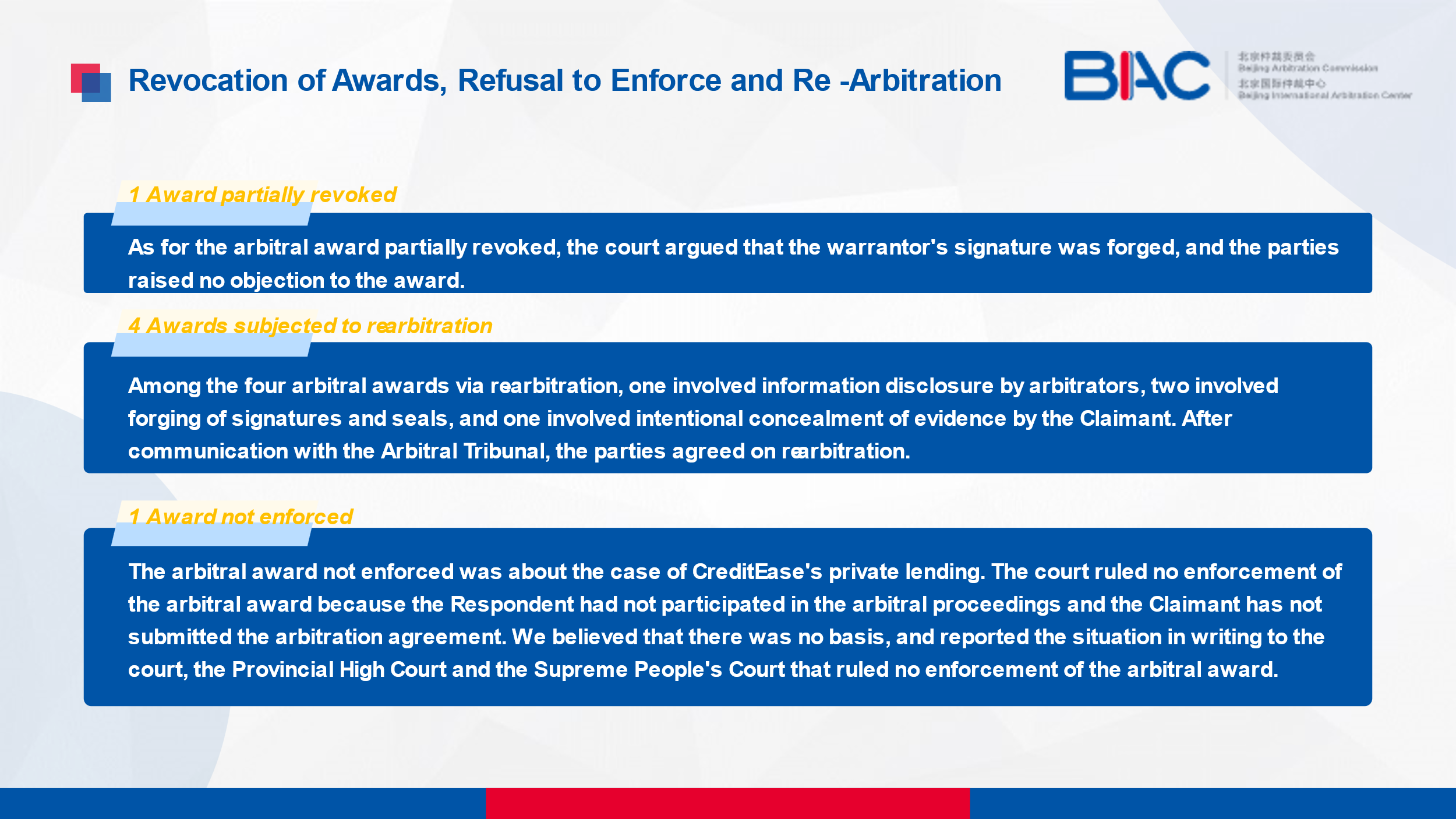
(IV) Arbitrator Management
1. Arbitrators' Involvement in Arbitration Case
2021 saw the involvement of 489 arbitrators (accounting for 70.56% of all BAC/BIAC arbitrators) in arbitration cases, totaling 9,274 person-times. To be specific, nine were foreign arbitrators (accounting for 1.84% of all arbitrators involved), totaling 83 person-times (comprising 0.89% of total person-times); 151 were females (accounting for 30.88% of all arbitrators involved), totaling 3,228 person-times (comprising 34.81% of the total person-times).
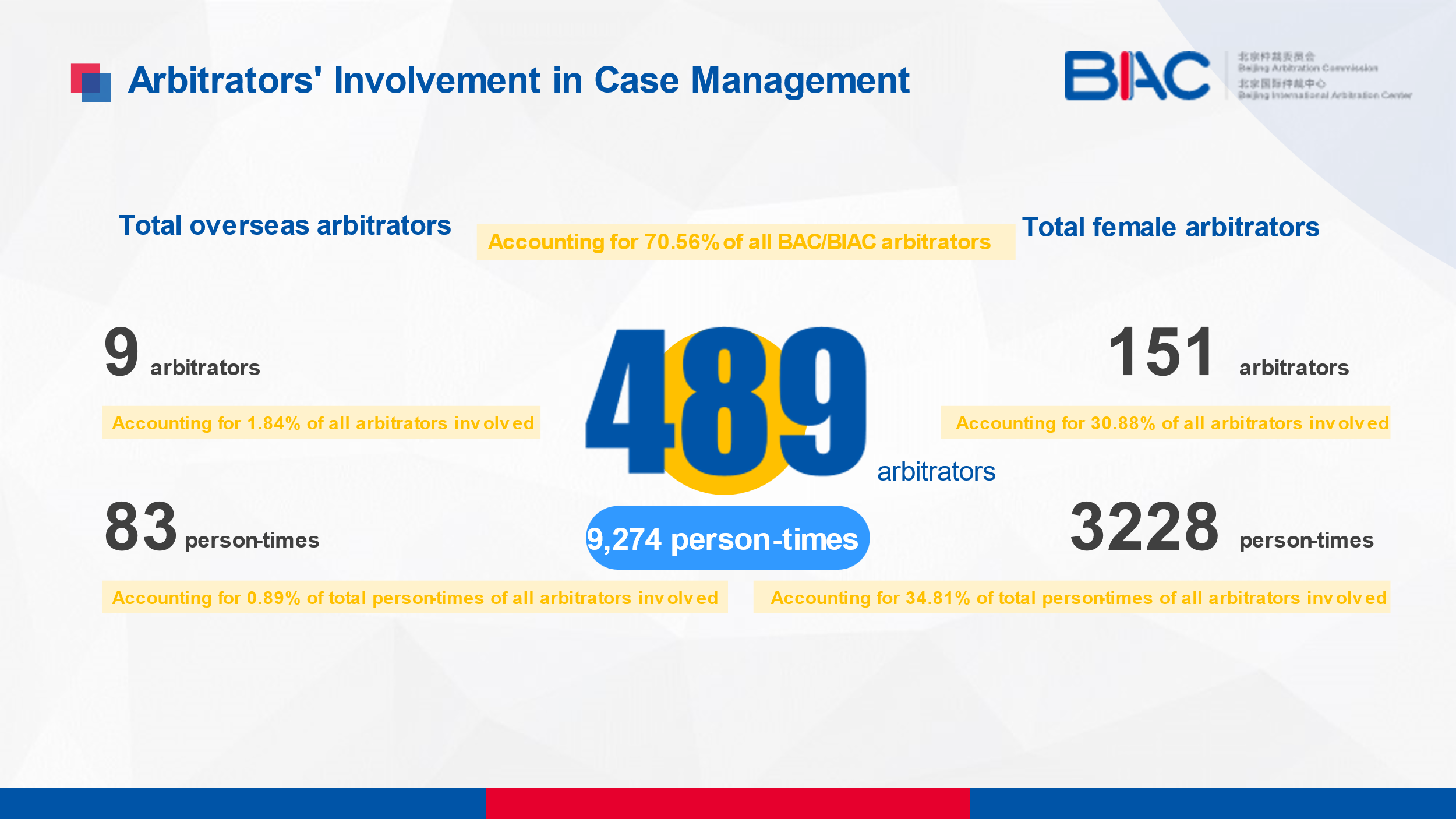
2. Appointment or Nomination of Arbitrators
|
Indicators |
Arbitrators |
Person-times |
Total |
Year-on-year Growth (person-times/rate) |
|
Arbitrators appointed by the Chairperson of the BAC/BIAC |
Presiding arbitrators |
1300 |
7581 |
2182/40.41% |
|
Sole arbitrators |
5285 |
|||
|
Co-arbitrators |
996 |
|||
|
Arbitrators nominated by both parties |
Presiding arbitrators |
15 |
28 |
3/12% |
|
Sole arbitrators |
13 |
|||
|
Arbitrators nominated by one party |
Arbitrators for the Claimants |
974 |
1528 |
168/20.84% |
|
Arbitrators for the Respondents |
554 |
79/16.63% |
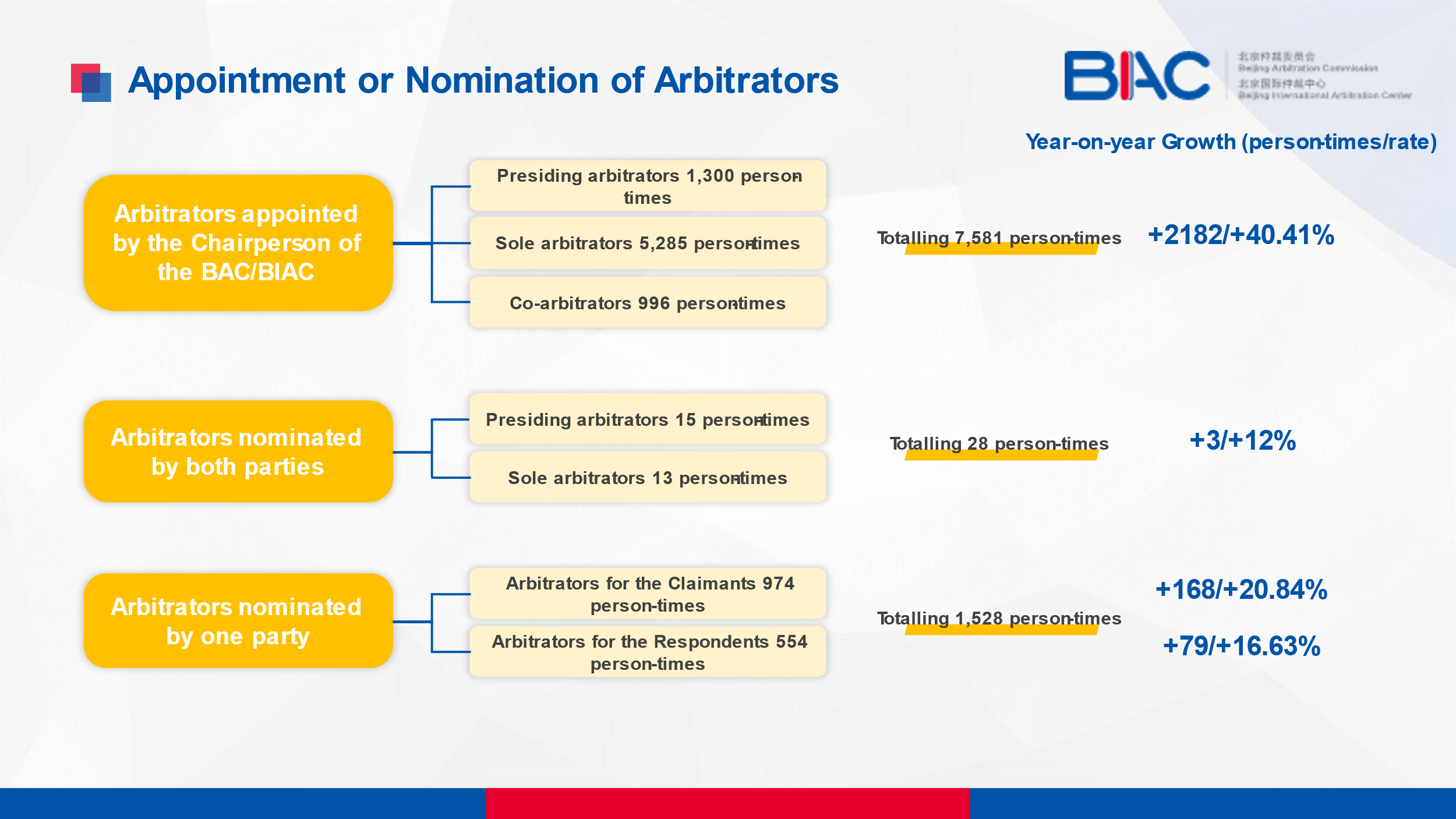
3. Challenges to Arbitrators
2021 saw 46 challenges to the arbitrators made by concerned parties. Specifically, 39 were rejected by the Chairperson because the alleged reasons for challenges were not found; the arbitrators in 7 cases volunteered to withdraw.
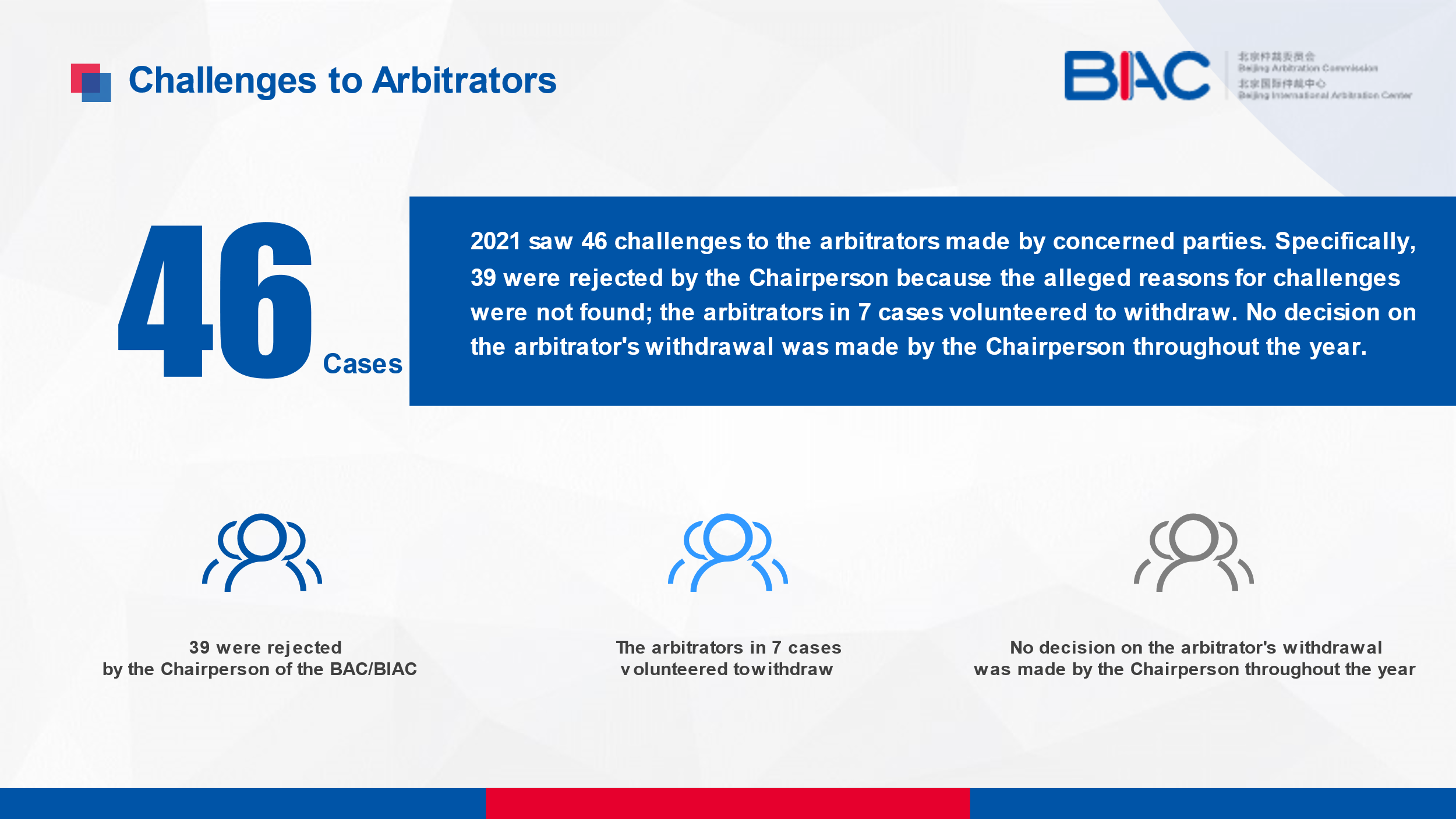
4. Procedural Dominance Transferring Cases
A total of 224 arbitrators applied to participate in the procedural dominance transferring cases, of which 62 actually undertook 68 pilot cases, including 21 expedited procedures and 47 ordinary procedures.
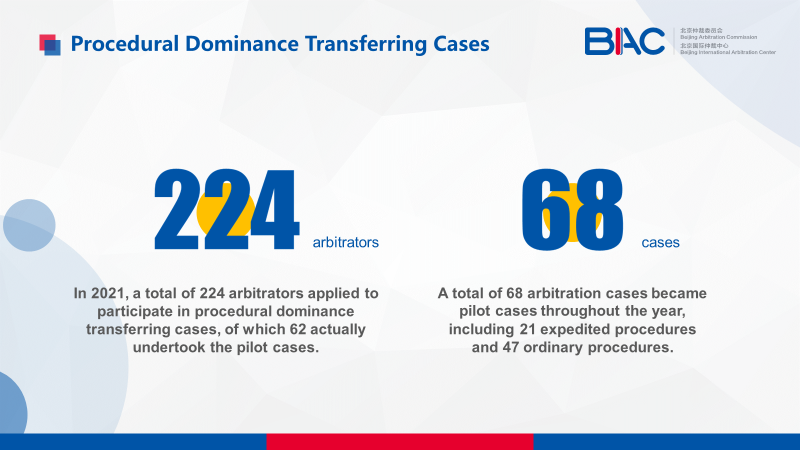
5. Hourly Rate of Arbitrators
Arbitrator's fees were charged on an hourly basis in 23 cases, with an increase over the previous two years (there was a total of two cases in 2019 and 2020). Among them, there were 12 investment and financial disputes, five credit and loan disputes, four warranty disputes and two sales contract disputes, with a combined amount in dispute of RMB 19.98 billion, accounting for 19.4% of the total amount in dispute in 2021, and an average amount in dispute of RMB 870 million. In some cases, the parties had not originally agreed to submit their disputes to the BAC/BIAC, but took the initiative to choose the BAC/BIAC to resolve their disputes after learning about the hourly rate system.
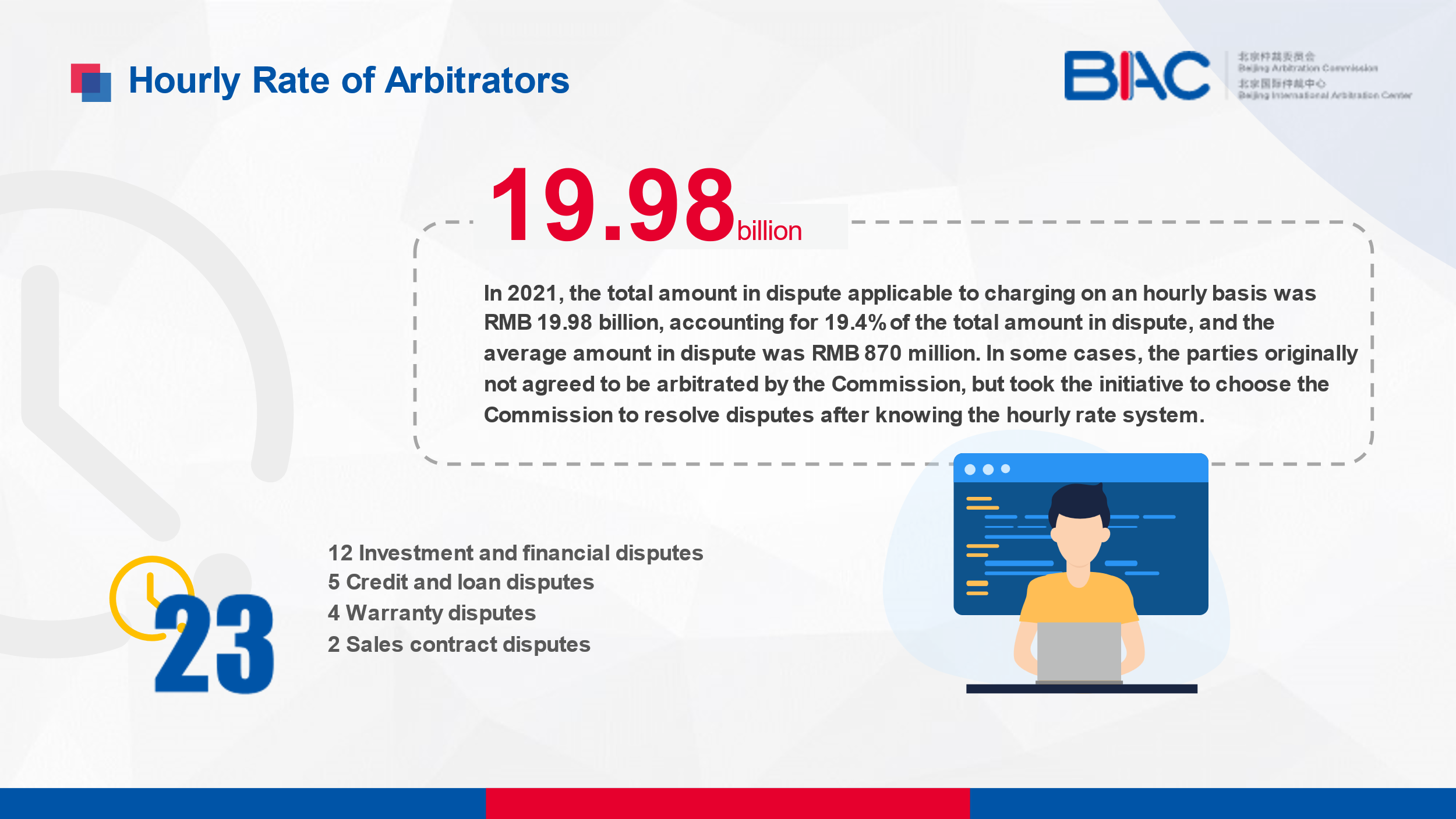
III. Priorities of the Committee
1. Revising the Articles of Association of the Beijing Arbitration Commission
2. Implementing Measures for Managing Labor Costs
3. Completing the first draft of the "BAC/BIAC Chronicles"
4. Expanding cases applicable to charging on an hourly basis
5. Promoting the trials of arbitral tribunal-dominated procedures
6. Issuing the Panel of Arbitrators for International Investment Arbitration
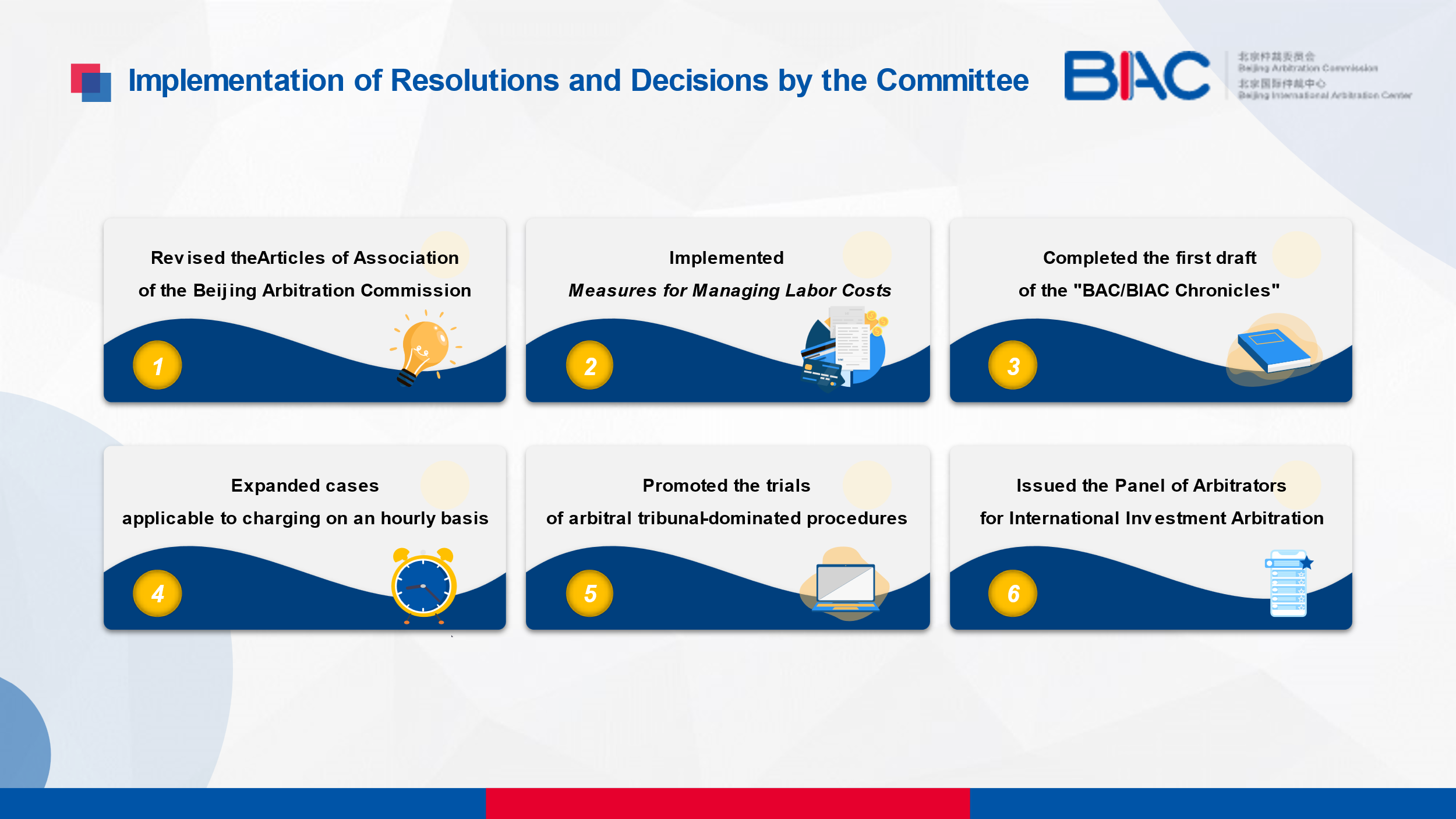
IV. Business Development and Brand Building
(I) Regular Business Development Work
The BAC/BIAC held 60 meetings, including 16 offline ones, eight online release conferences of the Annual Review And Preview, and 36 online courses under "Meet the Arbitrators." A total of 174 guest speakers and 146 cooperative partners were invited, harvesting 1,609,933 views through live broadcast and playback channels from 32 countries and regions, with a significant increase from 2020.
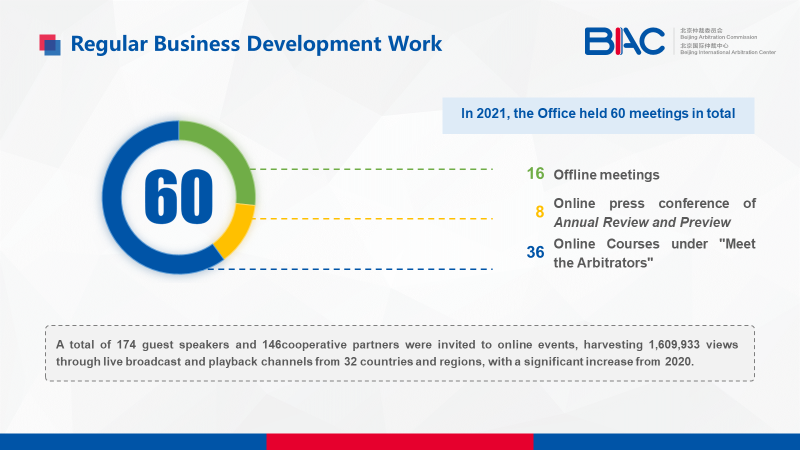
The accumulated number of clients increased by 10,368 from 21,482, up by 48.26%. The BAC/BIAC's WeChat Official Account published 256 articles or messages on activities including 49 professional research articles, and gained 11,481 new followers, accounting for 1/4 of the total (45,737), with 54.44% of followers from areas outside Beijing. The BAC/BIAC's LinkedIn platform pushed 61 professional articles and messages on activities, with pageviews of 12,917 person-times and a total of 1,252 followers, 71.9% of whom were from overseas. According to LinkedIn's official ranking of international arbitration institutions, the BAC/BIAC ranked first among arbitration institutions in the Mainland China in terms of the number of followers and interactions. The BAC/BIAC also set up a platform on Twitter to provide arbitration information for a greater number of overseas clients. Moreover, by selecting the latest trends and theoretical research results of the BAC/BIAC and the industry, the BAC/BIAC sent them 12 BAC/BIAC monthly newsletters in both Chinese and English (including 20 pieces of BAC/BIAC news, 126 pieces of BAC/BIAC and industry news, and 114 BAC/BIAC and industry research articles), and also advanced key expansion and cooperation projects by pushing feature articles (such as "Meet the Arbitrators" and the "Annual Review and Preview"); in total, 88,647 pieces of data were released throughout the year.
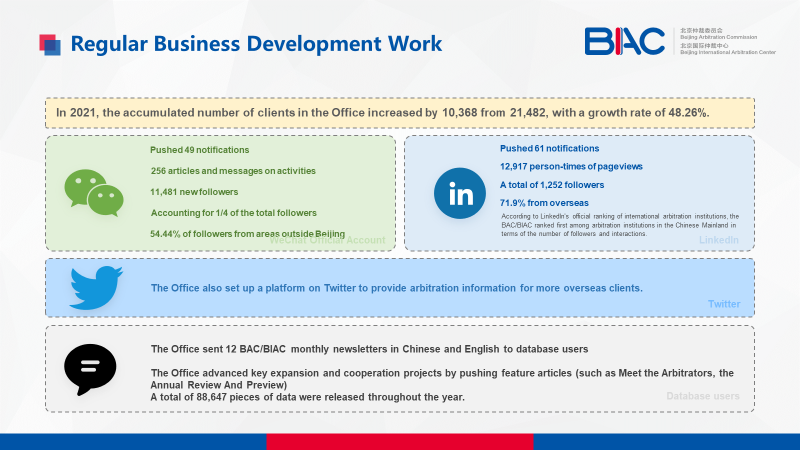
The BAC/BIAC completed the Annual Review and Preview in both Chinese and English (390,000 characters in the Chinese version and 170,000 words in the English version). The BAC/BIAC also held the Annual Summit on Commercial Dispute Resolution in China online, which attracted a total of 1,675 live viewers and was co-organized by the BAC/BIAC and eight overseas institutions, namely the Arbitration Foundation of Southern Africa; Asian International Arbitration Center; Chartered Institute of Arbitrators; Cairo Regional Center for International Commercial Arbitration; International Arbitration Center of the Astana International Financial Centre; Judicial Arbitration and Mediation Services, Inc. from the U.S.; Queen Mary University of London; and Thailand Arbitration Center.
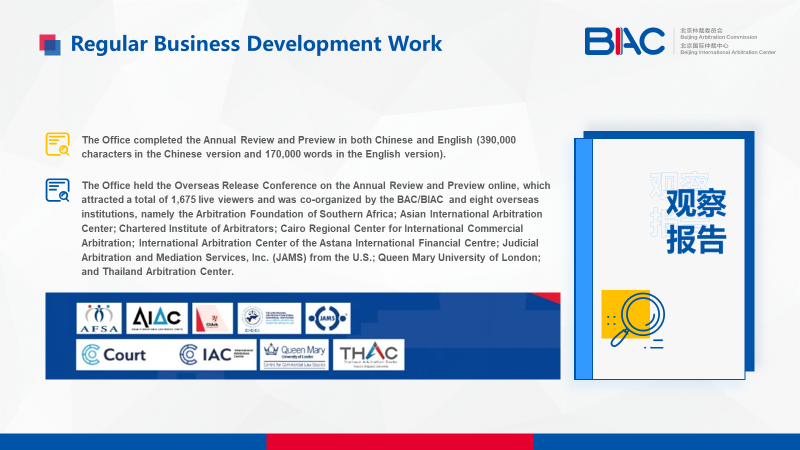
The BAC/BIAC carried out four training sessions for foreign-related law service talents with 320 trainees. It also carried out 13 special training sessions for enterprises, associations, etc., and received ten visits from Party and government sectors, five important investigations, ten visits from industry associations and 18 visits from enterprises, law firms and other institutions and departments. In addition, it attended 16 international conferences and 32 domestic conferences.
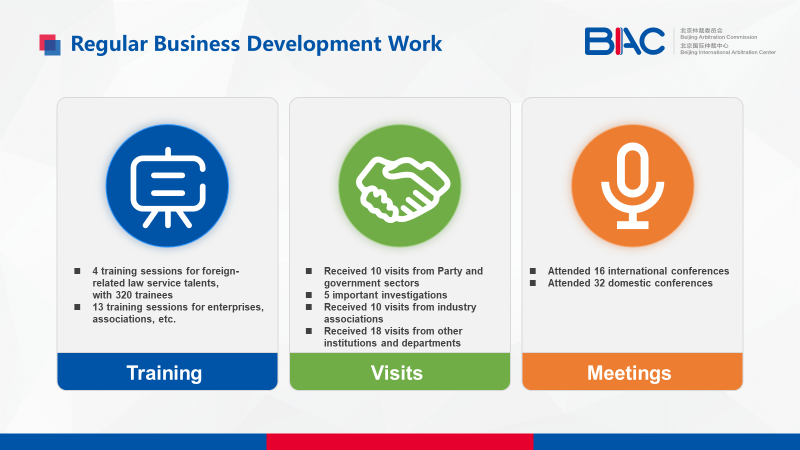
The Scholarship Program for University Students from Central and Western China progressed smoothly. Sichuan University, Wuhan University, Lanzhou University, Guizhou University, Zhongnan University of Economics and Law, Northwest University of Politics and Law, and Hunan University completed the assessment and selection of scholarship winners, covering 102 students.
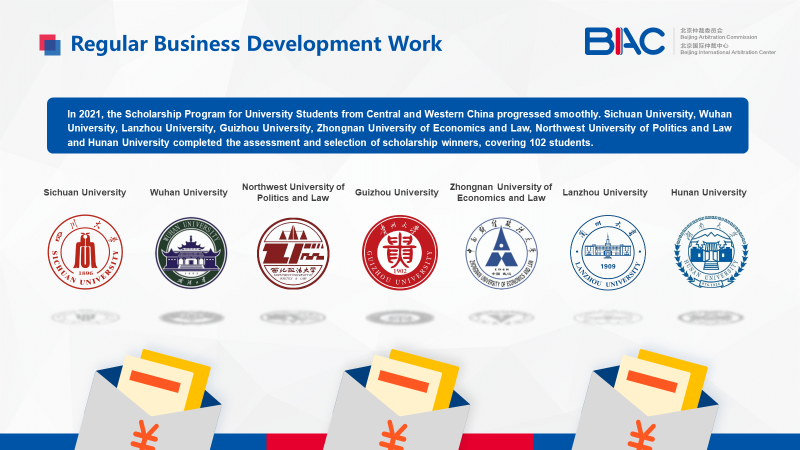
The BAC/BIAC published the Investment Treaty Arbitration as Public International Law: Procedural Aspects and Implications (with a total of 216,000 characters) under the BAC/BIAC translated book series, and completed project approval for the Model European Rules of Civil Procedure: Provisions and Commentaries and Concept of Arbitration. The BAC/BIAC approved the establishment of the BAC/BIAC Book Collections and published the Guide to Dispute Resolution of Construction Delay (with a total of 860,000 characters), which was the first monograph on the dispute resolution of construction delay in China. The BAC/BIAC completed four volumes of "Beijing Arbitration Quarterly" with a total of about 500,000 words, and the masking and indexing of more than 8,300 statements of mediation and arbitral awards in Phase II of the case library. So far, most of the relevant arbitral awards and statements of mediation from 2015 to 2019 have been processed and are available for inquiry and use.

The BAC/BIAC actively participated in the construction of the "Pilot Free Trade Zone and National Comprehensive Demonstration Zone for Expanding Opening-up in the Services Sector," provided suggestions and recommendations on the issuance of several policy documents and institutional measures with more than 200,000 characters, and provided practical support for the construction of the capital's business environment and international arbitration center.
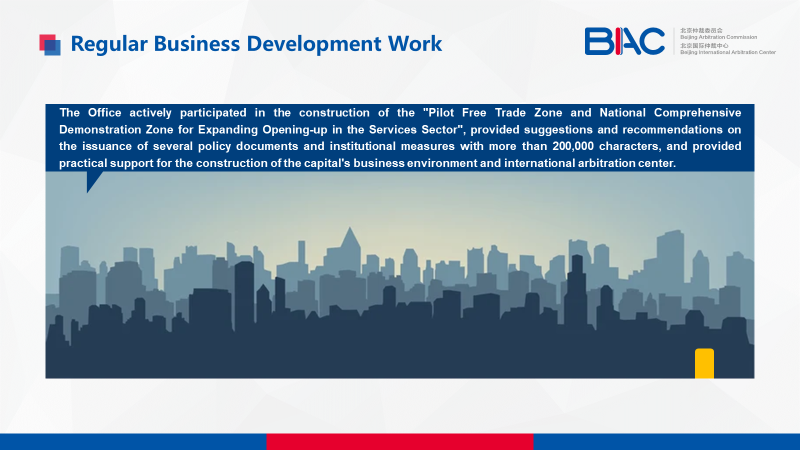
(II) Major Business Development Work
1. Holding the First China Legal Forum on International Trade in Services
On 3 September, the First China Legal Forum on International Trade in Services was held, co-sponsored by the BAC/BIAC, Beijing Municipal Bureau of Justice and China Association of Trade in Services. The Vice President of the Supreme People's Court, Vice Minister of the Ministry of Justice, Vice Mayor of Beijing and Secretary-General of UNCITRAL attended and addressed the conference through both online and offline channels. The Forum was broadcast live on both Chinese and English channels, and viewed by more than 30,000 person-times worldwide. It was the subject of reports by many domestic mainstream media groups, and rated as one of the most excellent forums of this year by the organizing committee of the China International Fair for Trade in Services, and one of the top 10 typical cases of the international dissemination of the Chinese legal system in 2021 by the Institute of the Comprehensive Rule of Law of the China University of Political Science and Law, a neutral third-party institution.
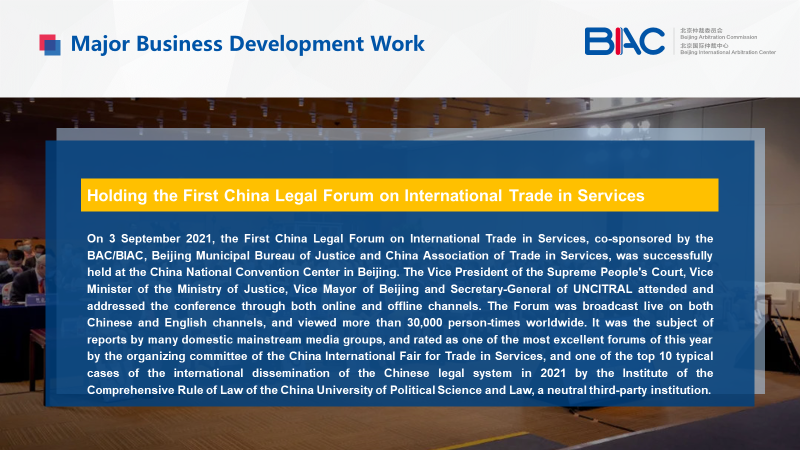
2. IPBA Breakfast Symposium and Release of Dispute Resolution Report on International Construction Projects along the Belt and Road
On 20 April, the BAC/BIAC held the Breakfast Symposium on "'Belt and Road' Dispute Resolution: Empirical Research and China's Response" at the 30th Annual Meeting of the Inter-Pacific Bar Association ("IPBA") to conduct in-depth exchanges on the exploration and reform of the internationalization of arbitration institutions, cultivation of international arbitration talents and empirical research on dispute resolution under the "Belt and Road Initiative." The Dispute Resolution Report on International Construction Projects along the Belt and Road, co-authored by the BAC/BIAC, China International Contractors Association, Department of Engineering Management of Tianjin University and invited experts, was released at the meeting. More than 140 guests participated in this conference offline.
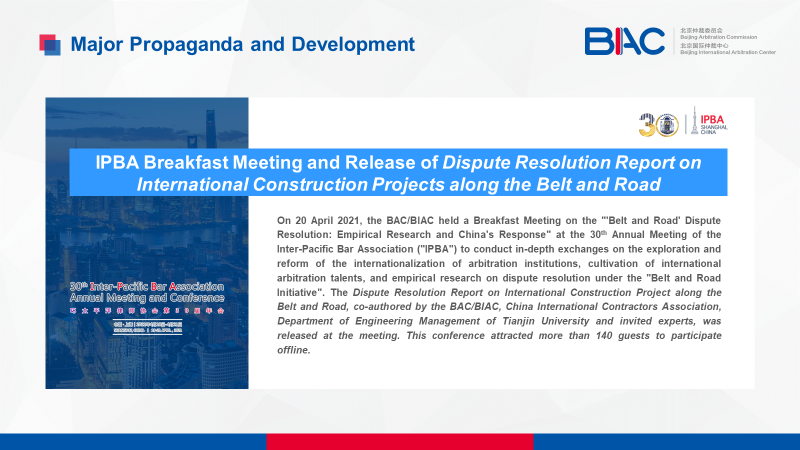
3. Improving Supporting Measures for the International Investment Dispute Settlement Mechanism
The BAC/BIAC released the Panel of Arbitrators for International Investment Arbitration and Code of Conduct for Arbitrators in International Investment Disputes. It also published the Interpretations of International Investment Arbitration Rules to facilitate the accurate understanding and application of the BAC International Investment Arbitration Rules.

4. Online Courses under "Meet the Arbitrators"
With 36 course sessions under "Meet the Arbitrators" as the core, the in-depth and professional development of online activities was promoted. Under the circumstances of the continuous influence of the COVID-19 pandemic on the normal holding of offline conferences, numerous options for online conferences and viewers' gradual aesthetic fatigue, in combination with the implementation of the Civil Code and other important practical and theoretical issues, the BAC/BIAC committed itself to create professional quality courses and extended the course themes to engineering real estate, foreign investment, civil aviation and other fields under the Civil Code.
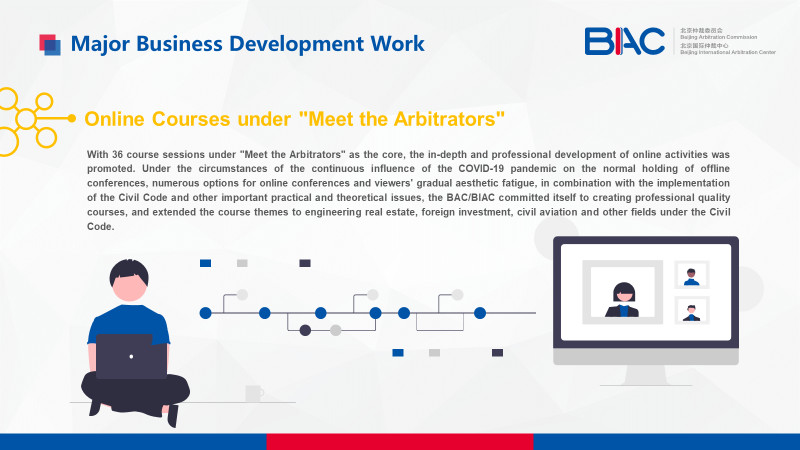
5. Promoting Practice Courses in Universities
The BAC/BIAC kept on promoting International Commercial Arbitration Theory and Practice Courses, and offered a total of 11 courses in well-known universities in Beijing, Shanghai, Guangzhou and Shenzhen. The BAC/BIAC fully or partially offered such courses as International Commercial Arbitration Theory and Practice, English Contract Law and Evidence Law at the University of International Business and Economics, Peking University School of Transnational Law, China University of Political Science and Law, Beijing Normal University, Fudan University, East China University of Political Science and Law and Sun Yat-sen University. It cooperated with the China Education Development Foundation for the first time in establishing a special fund for the "BAC/BIAC International Commercial Arbitration Talent Training Program" to ensure the smooth development of the course program and further standardize and consolidate the course outcomes.
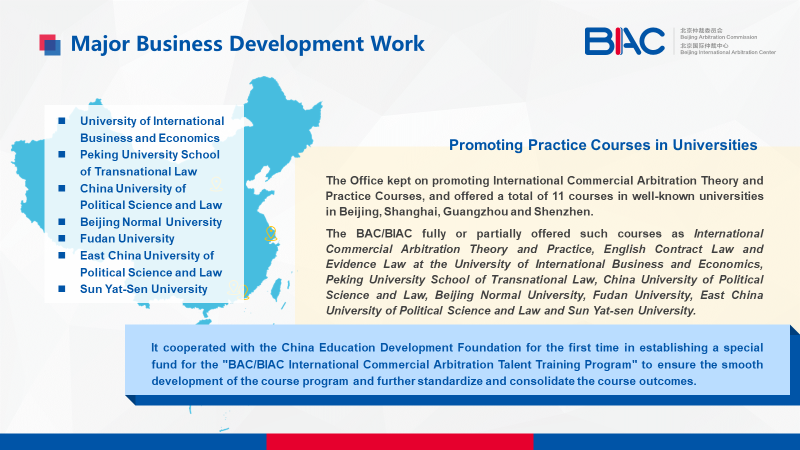
6. Joint Organization of a Series of Training Courses on International Investment Arbitration
The BAC/BIAC jointly organized a series of training courses on international investment arbitration with the International Centre for Settlement of Investment Disputes (ICSID) and Permanent Forum of China Construction Law (PFCCL). The course consisted of four lectures respectively delivered by Ms. Meg Kinnear, Vice President of the World Bank Group and ICSID Secretary-General, and ICSID Legal Counsel, in which they introduced the basic situation of the ICSID's investment arbitration, arbitral proceedings, rule revision, arbitral award enforcement, etc.
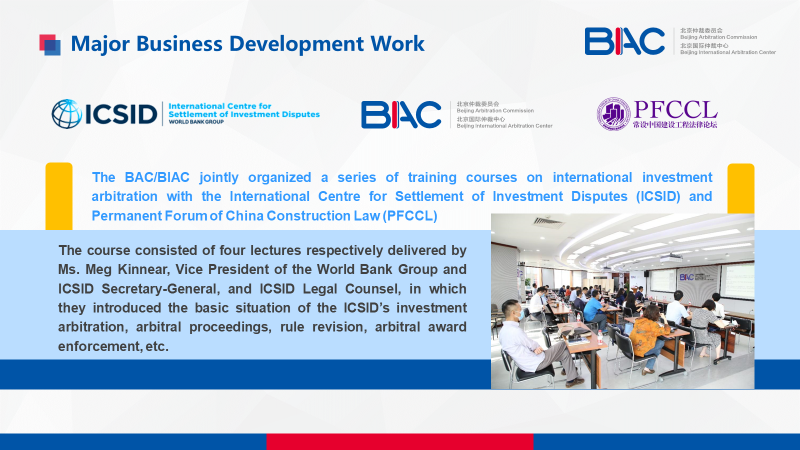
V. Internal Management and Services
(I) Construction of Internal Management Standardization
In accordance with the refined management requirements proposed by the Committee, the BAC/BIAC requested the Committee to revise and improve a series of internal standards including the Arbitration Rules and Measures for the Administration of the Appointment of Arbitrators, and further strengthen the enforcement and implementation of the system.

(II) Talent Team Building
In order to further motivate employees and improve their work enthusiasm and initiative, the Compensation, Benefit and Performance Management System was revised, and the compensation structure and levels of employees were adjusted, which had a significant effect on the improvement of employees' work efficiency.
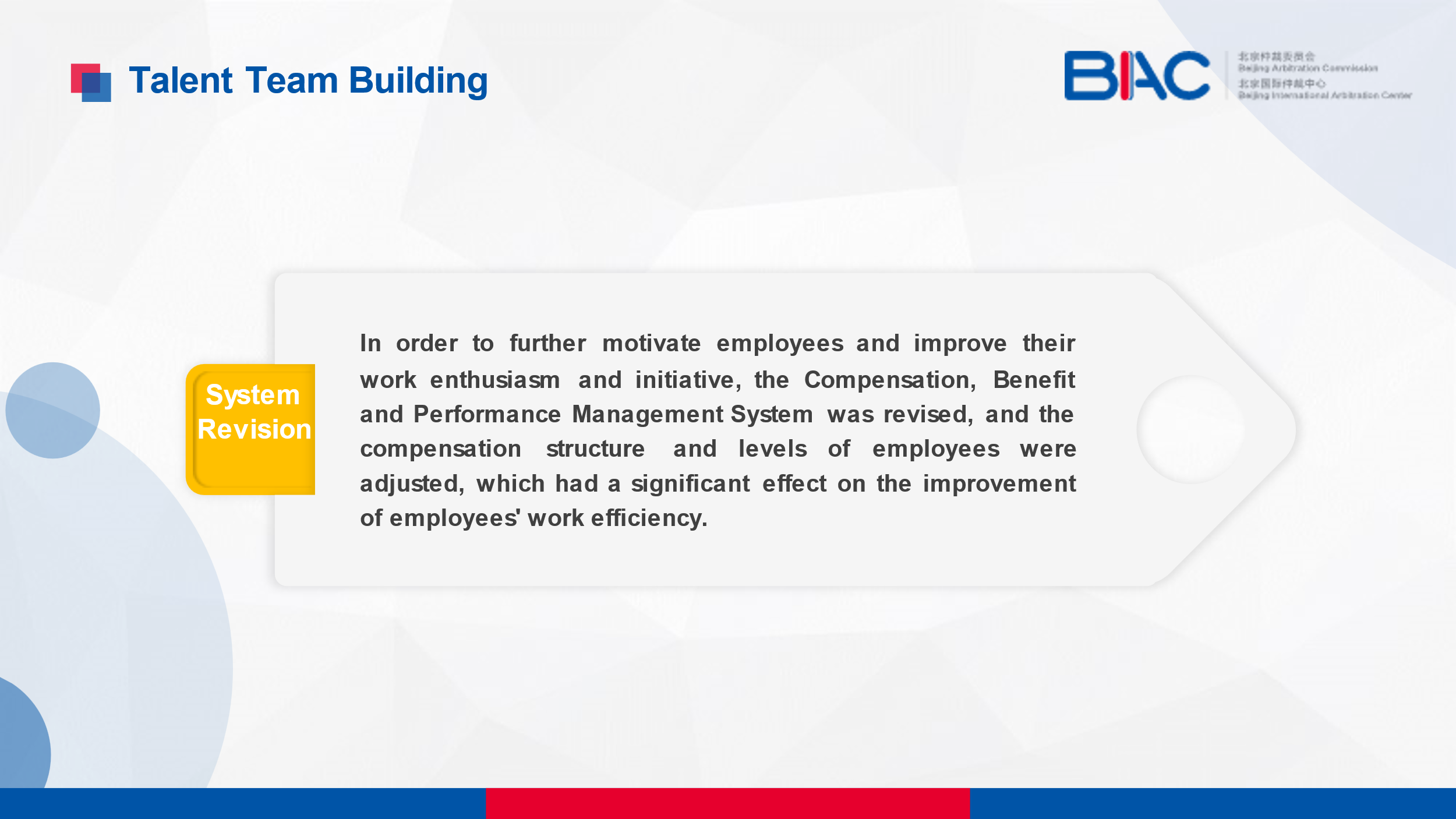
(III) Information Technology Construction
In order to optimize the implementation of the attendance system, an attendance management system was developed; in order to improve the efficiency of official document management, an official document management system was developed; and in order to facilitate the updating of information on arbitrators, an arbitrator information filling system was developed.
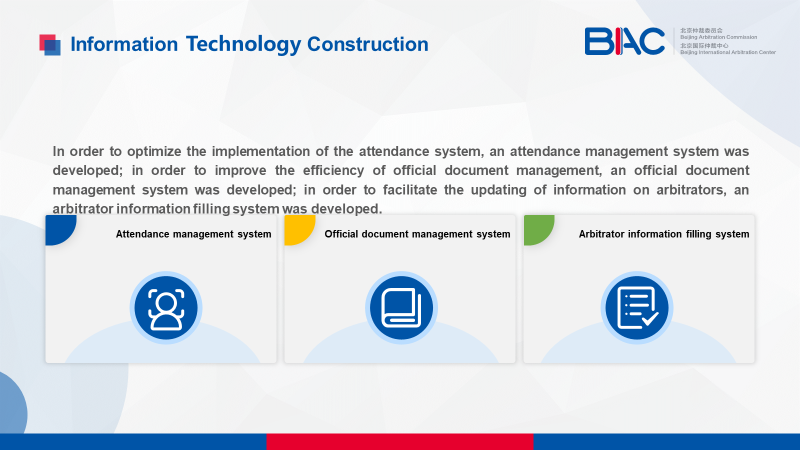
(IV) Daily Work of Comprehensive Management Services
With the large increase in the number of cases registered and concluded, and the increasing attention paid by all parties to the BAC/BIAC, the daily workload of comprehensive management and services saw substantial growth. The BAC/BIAC made concerted efforts to overcome all difficulties and finally ensured the smooth operation of the unit.
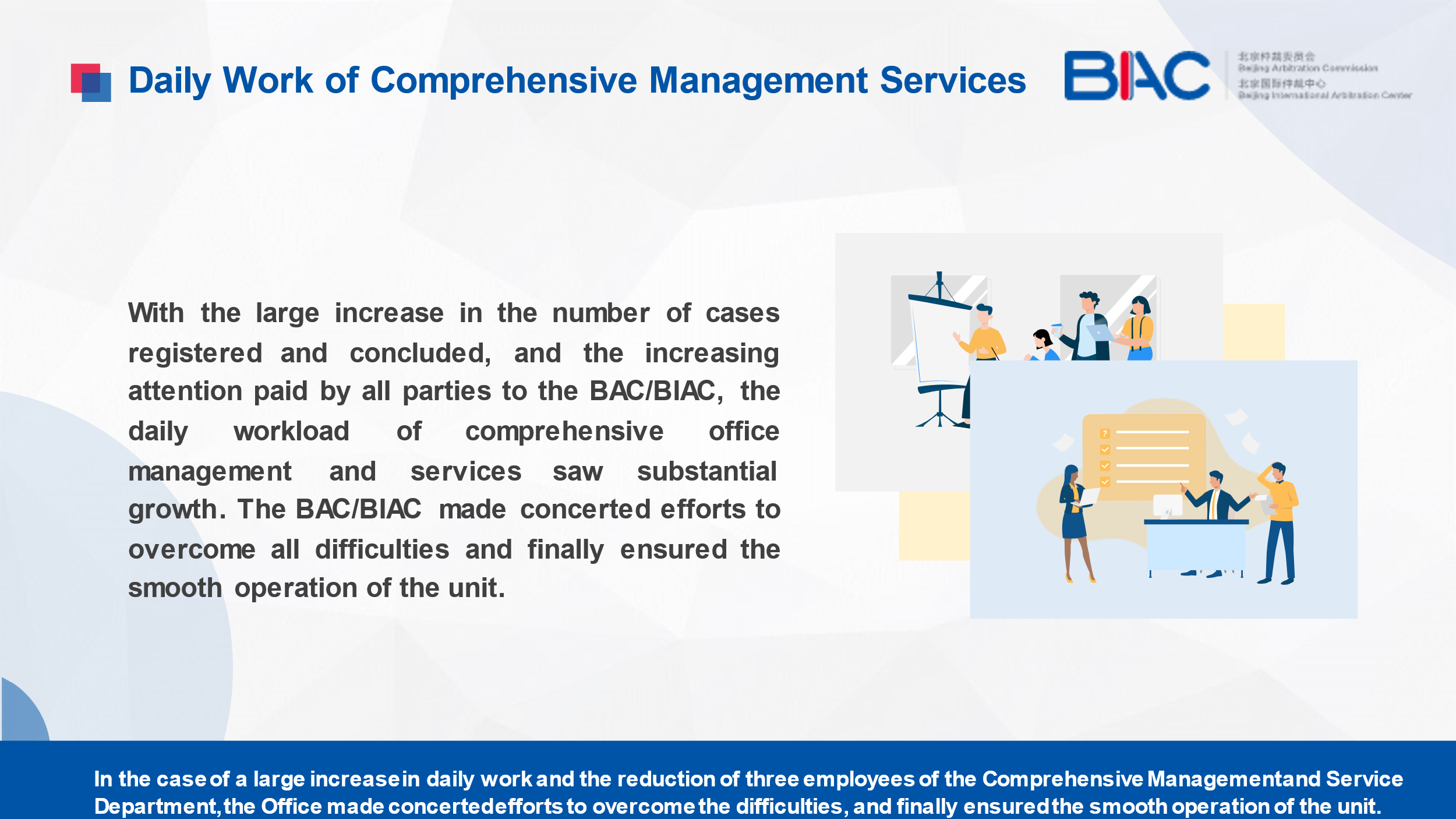
(V) Progress in Party Building and Party Affairs
On the basis of adhering to the implementation of the "Three Meetings and One Lecture" system, the General Party Branch Committee and all branches actively carried out the study and education of Party history, earnestly studied the spirit of General Secretary Xi Jinping's "1 July" important speech and internal Party rules, thoroughly implemented the spirit of the warning education conference of "taking cases as references and promoting reform through cases," and earnestly studied, publicized and implemented the spirit of the Sixth Plenary Session of the 19th CPC Central Committee.
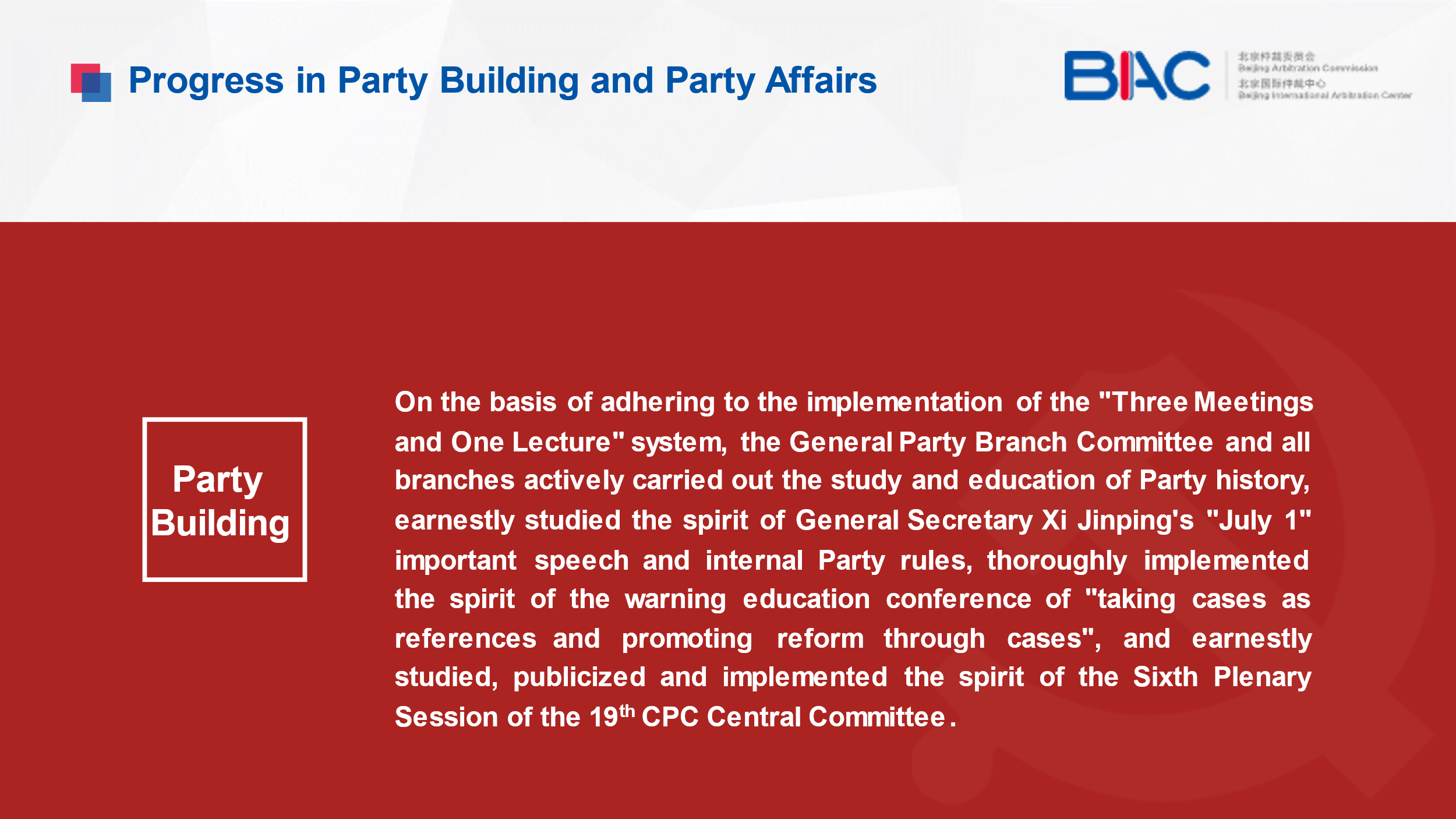
VI. Highlights and Deficiencies in 2021
(I) Main Highlights
1. Forging ahead with determination and tackling difficulties to improve the quality and efficiency of work
In 2021, the total cases registered and total cases concluded increased by 37.74% and 36.82%, respectively, and the corresponding workload of publicity expansion and function support also increased significantly. Facing manpower shortages and a surge in workload, the BAC/BIAC forged ahead with determination and tackled difficulties to improve the quality and efficiency of the work. As a result, case filing and handling, business development and function support were successfully completed with excellent performance in many indicators.
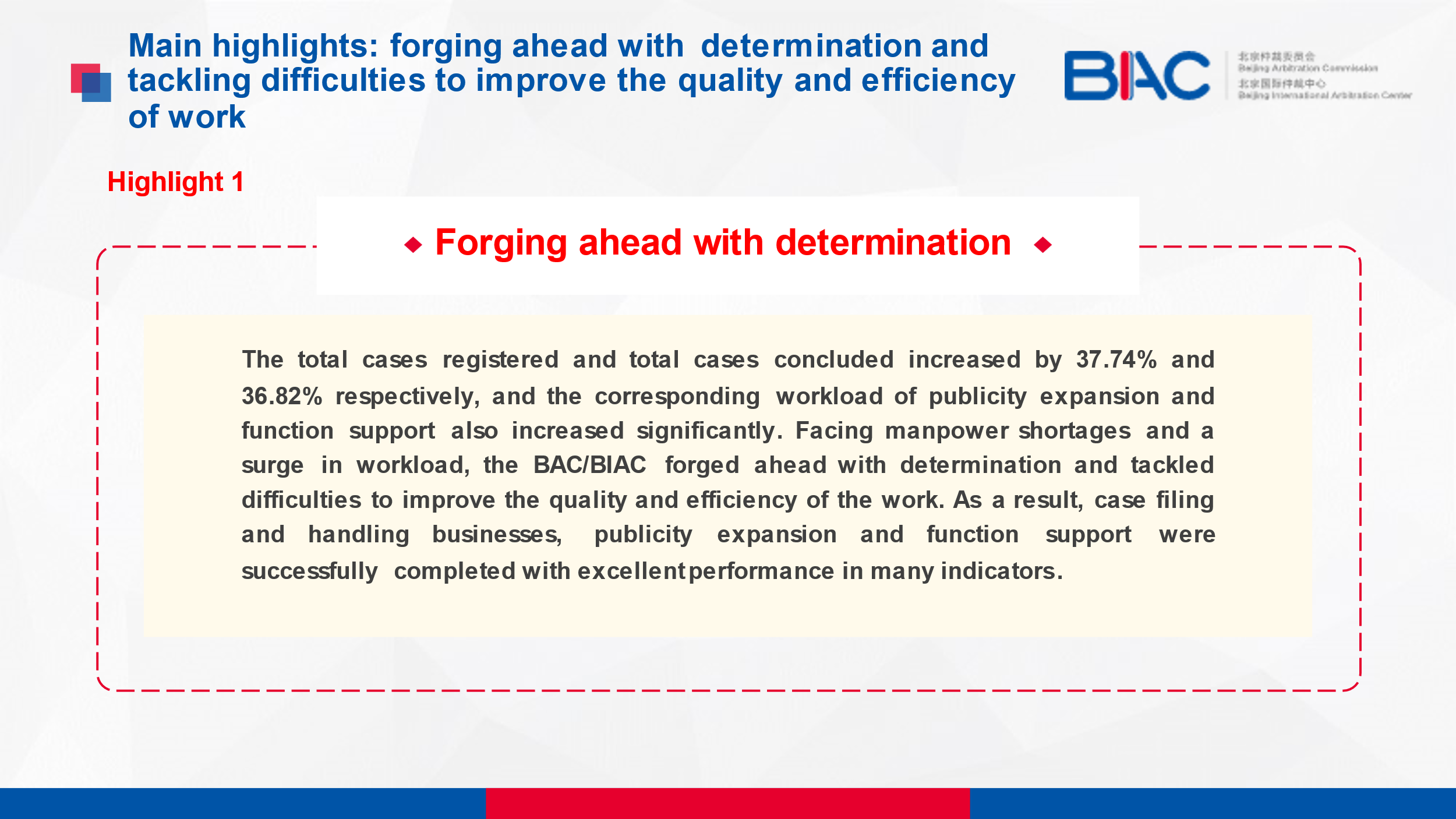
2. Upholding fundamental principles and breaking new ground, and exploring the road of transformation for the future
On the premise of adhering to fine traditions and ensuring the stability of the fundamentals, the BAC/BIAC sought innovations and explored forms of business transformation according to the future development trends of the organization. The Administration Division took the lead in innovating and optimizing the compensation system and performance evaluation scheme; the Business Development Division took the lead in making layouts surrounding hotspots in the industry; the Case Handling Division took the lead in innovating the charging and procedure management mode of the BAC/BIAC; and the Case Filing Division took the lead in improving the appointment system requirements.

3. Standardizing the system, consolidating the foundations and optimizing the management service
By taking audit, inspection and educational rectification as opportunities, the BAC/BIAC earnestly summarized the experience gained and lessons learned in order to strengthen the standardization and refinement of management and services. It also improved the Articles of Association, internal management systems of human resources and finance, Measures for the Administration of the Appointment of Arbitrators, Code of Conduct for Arbitrators in International Investment Disputes, Norms for the Standardization of the Case Handling Process, Norms for the Standardization of Construction Cost Appraisal, Case Handling Manual - Case Filing, Norms for the Standardization of Mail-in Case Filing Investigation, etc.
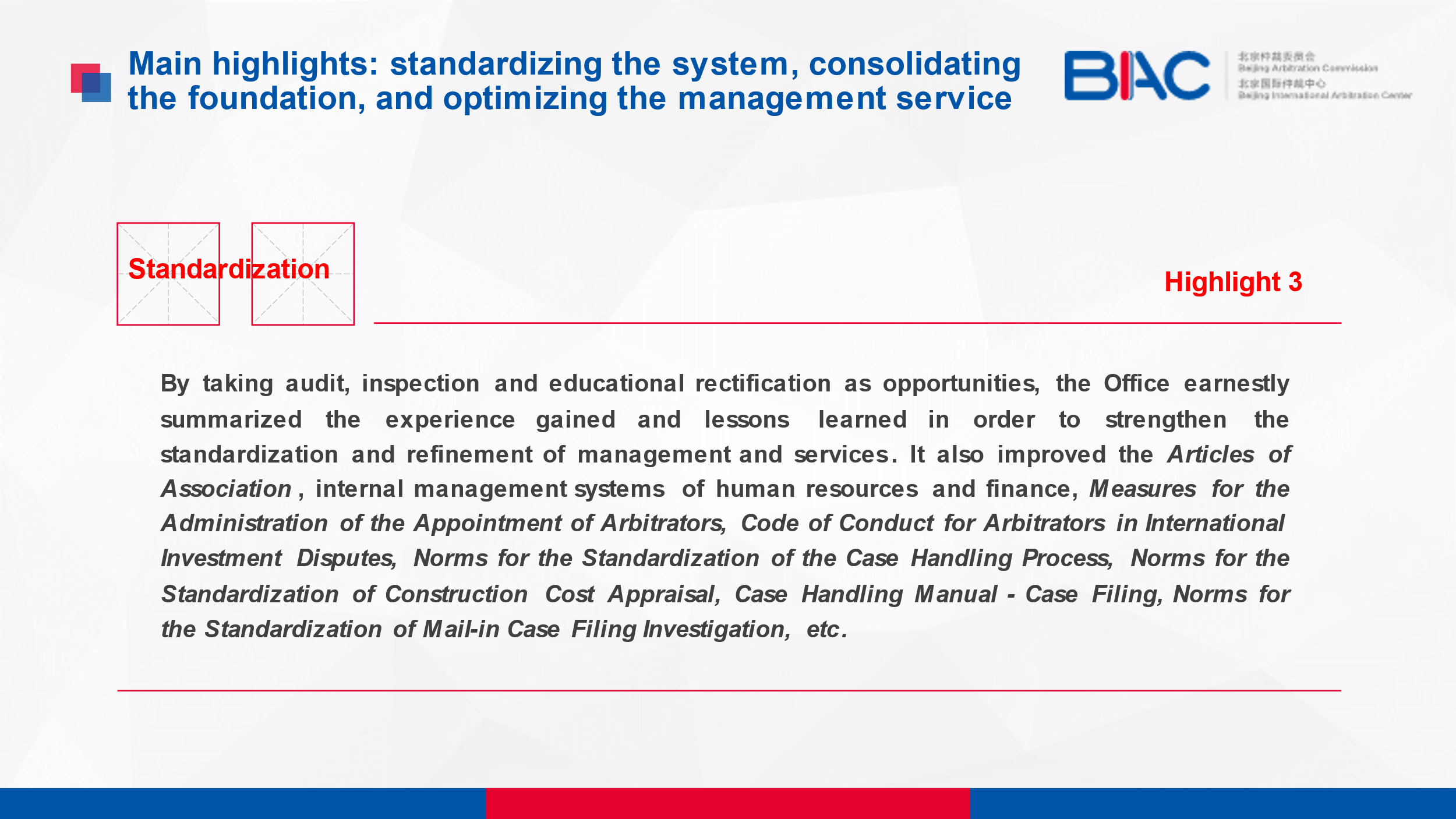
4. Keeping pace with the times, keeping up with the frontier and trying the latest practices
By referring to the latest practices in management, development, services and arbitration business at home and abroad, the BAC/BIAC made exploratory efforts and achieved good results. The Administration Division recorded and displayed attendance records, official documents and monthly reports in the information system; the Business Development Division issued conditional interim measures; the Case Handling Division optimized the practices of digital online hearings; and the Case Filing Division improved the review and acceptance process of mail-in filing.
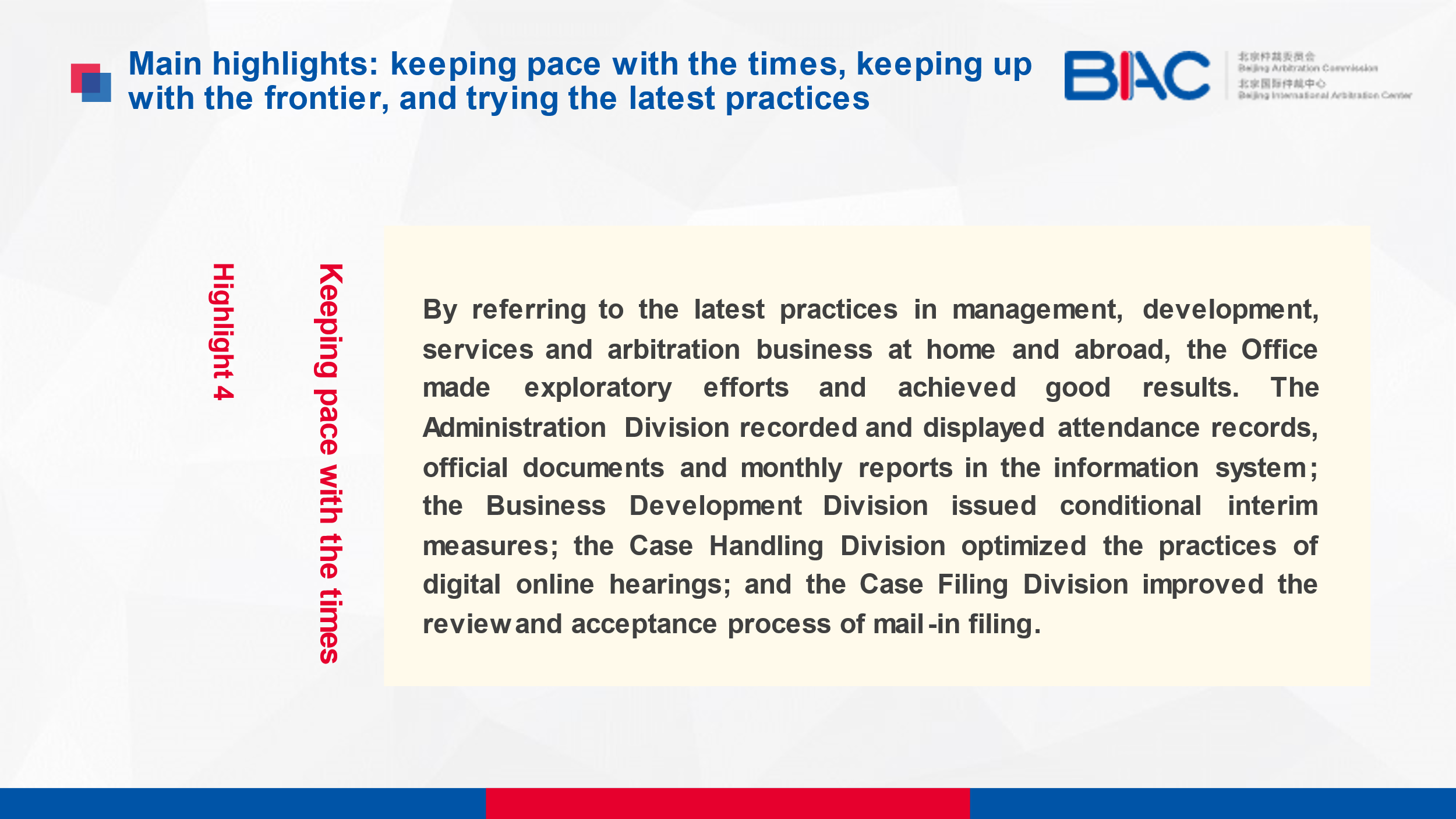
(II) Main Deficiencies
There were also several deficiencies in 2021, mainly reflected in the need for more accurate work prediction, further strengthening of the case handling system, further increase of investment in resource expansion, further improvement of case management and further enhancement of crisis handling capacity.

VII. Main Objectives and Initiatives for 2022
(I) Main Objectives
The year of 2022 will witness the 20th CPC National Congress, the endgame of the BAC/BIAC's Seventh Committee and the changing of the term of its arbitrators. It is also expected to be the year in which the institutional reform plan is finalized. In such an important year in the history of the BAC/BIAC, the BAC/BIAC will strive to make new achievements, step up to a new level and break new ground.
First, the BAC/BIAC will smoothly complete the change of the term of office of the Committee and arbitrators, complete institutional reform and ensure a united team, orderly organization, continuous work and unchanged standards.
Second, the BAC/BIAC will attract more outstanding arbitrators to join the BAC/BIAC, further improve the overall quality of arbitrators and enhance their case-handling capacity;
Third, the BAC/BIAC will further improve the service level of case management, upgrade the quality and efficiency of case handling, and enhance the credibility of the BAC/BIAC.
Fourth, the BAC/BIAC will make a strong expansion layout, actively update the concept of expansion, increase the coverage of expansion and expand the arbitration market inside and outside Beijing in a balanced manner;
Finally, the BAC/BIAC will fully integrate into the overall development of the country and Beijing, and contribute to major projects such as the "Belt and Road Initiative"; coordinated development of the Beijing-Tianjin-Hebei region; construction of the "Pilot Free Trade Zone and National Comprehensive Demonstration Zone for Expanding Opening-up in the Services Sector"; construction of "Safe Beijing"; construction of the Beijing international arbitration hub; cultivation of foreign-related legal talents; and Beijing Winter Olympics.
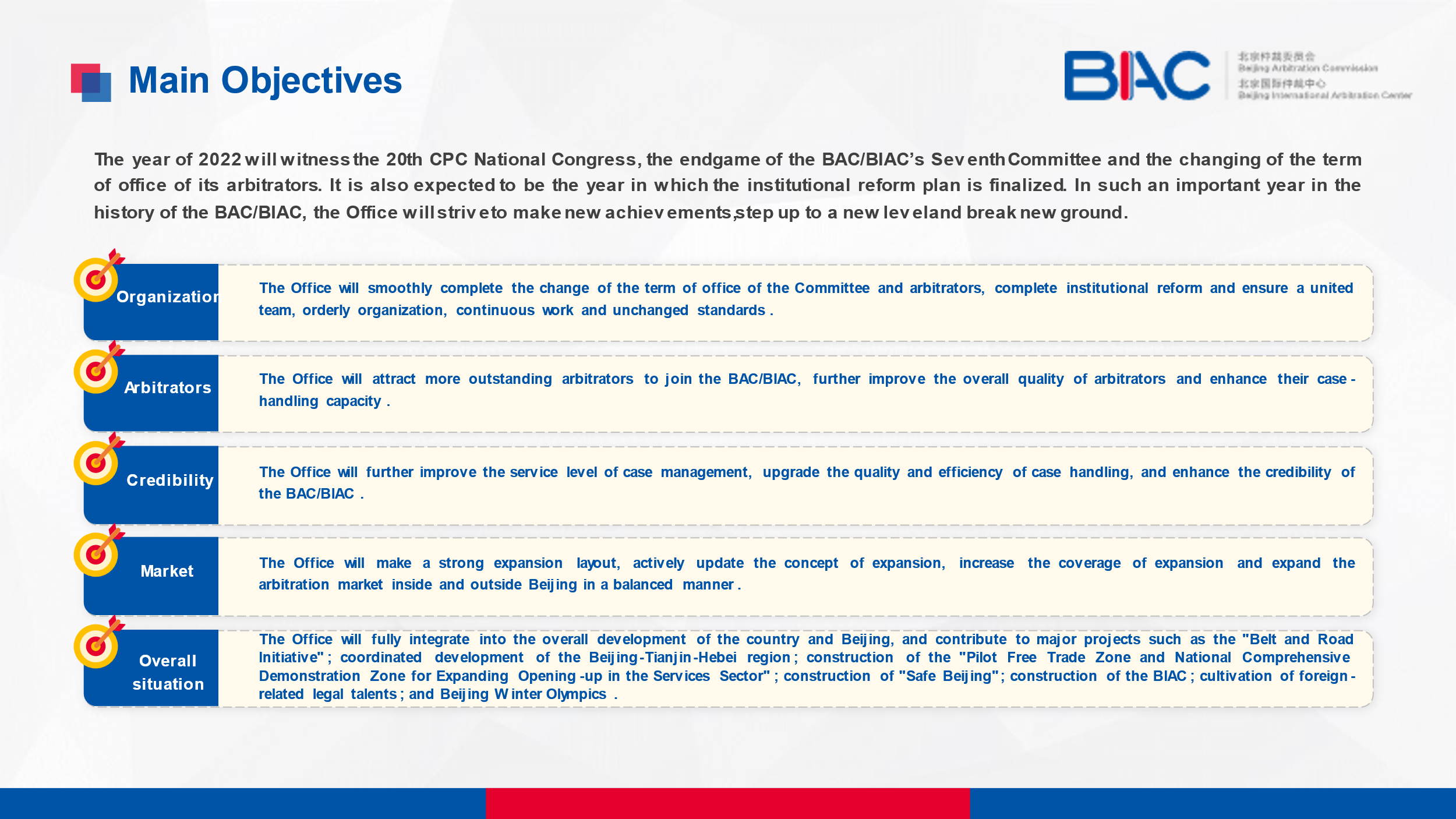
(II) Main Initiatives
1. Coordinating the implementation of institutional reform
2. Assisting in the smooth change of the term of arbitrators
3. Improving the model for the procedure management of arbitration cases
4. Studying and formulating plans for the construction of talent teams
5. Organizing and promoting the compilation of the "BAC/BIAC Chronicles"
6. Optimizing publicity, expansion and research systems and mechanisms
7. Properly promoting the construction of Phase I of a new case-handling system
8. Actively carrying out the design and decoration of the office space
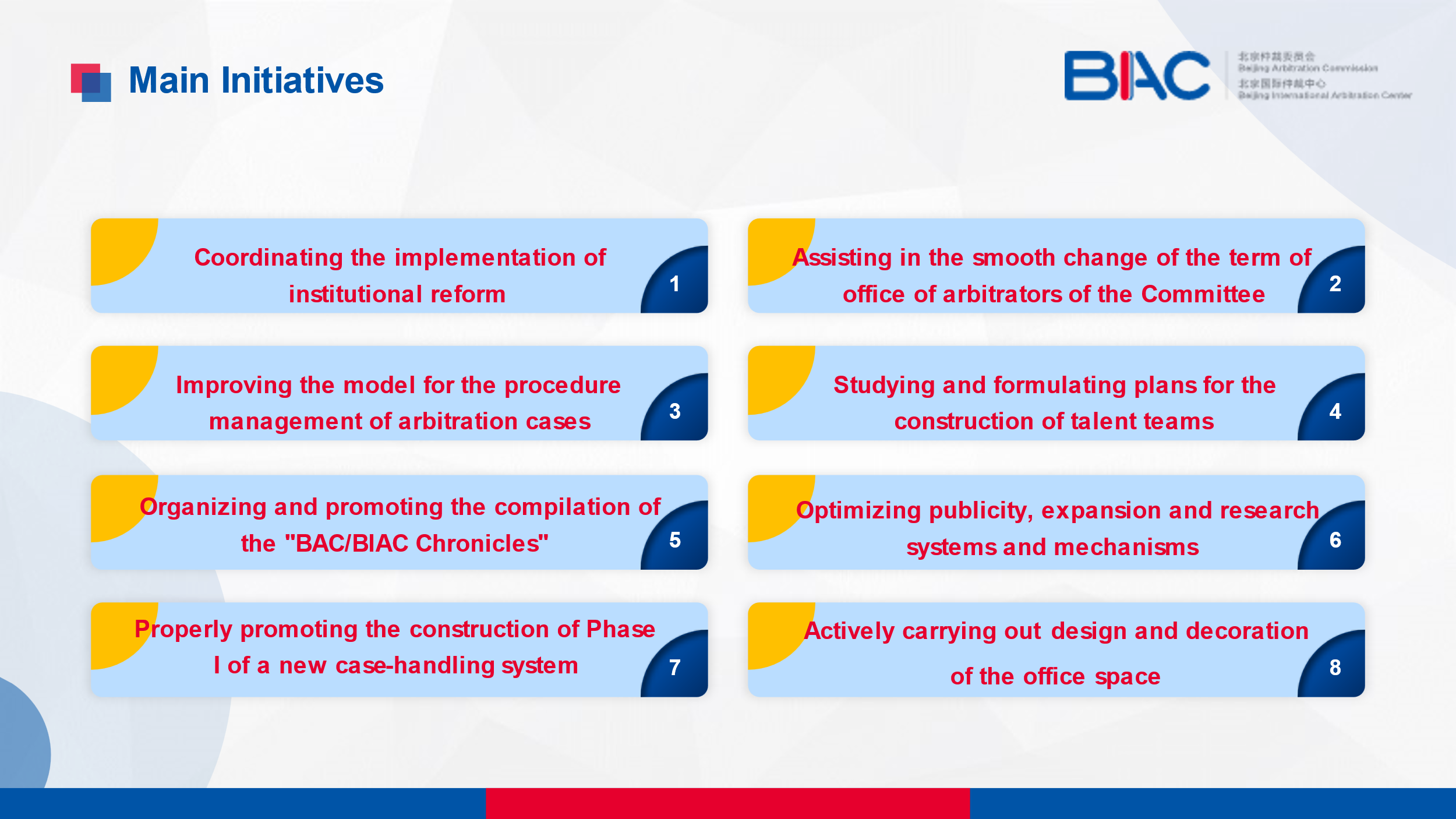
Beijing Arbitration Commission/Beijing International Arbitration Center
10 August 2022
